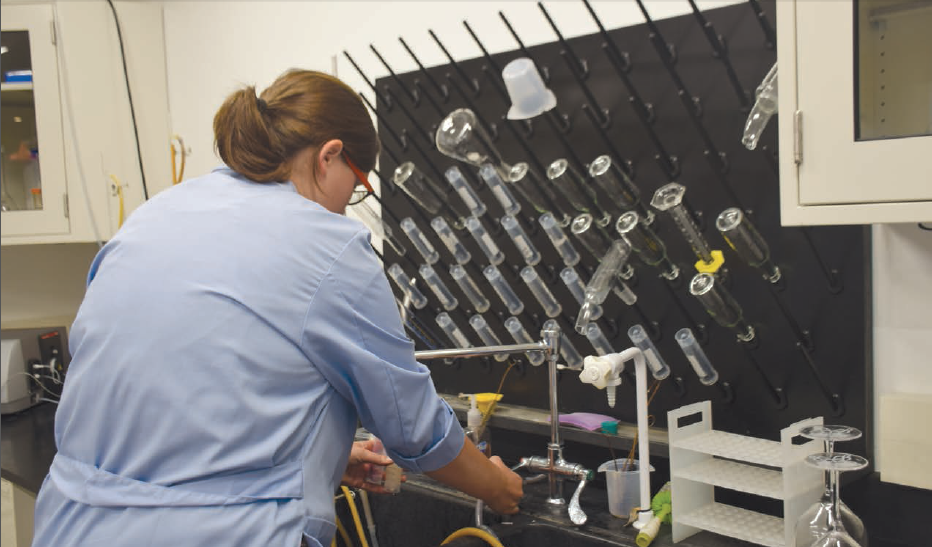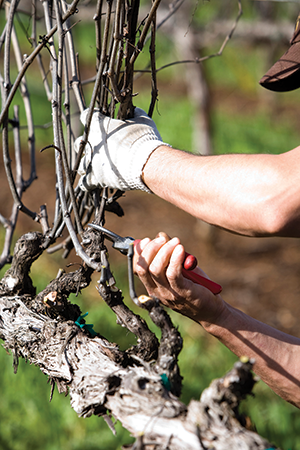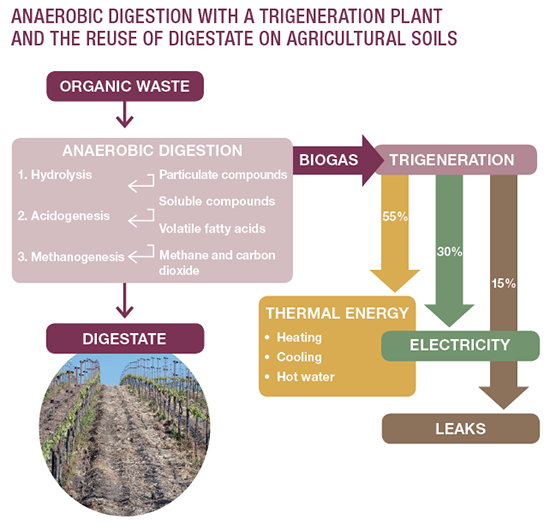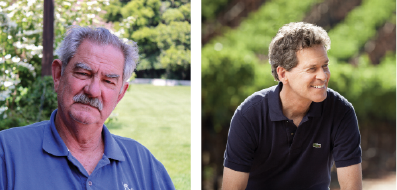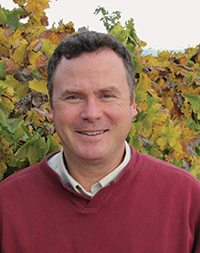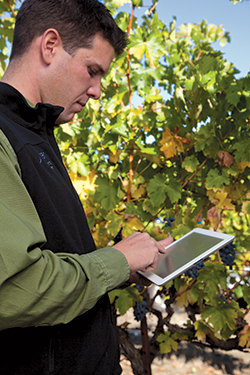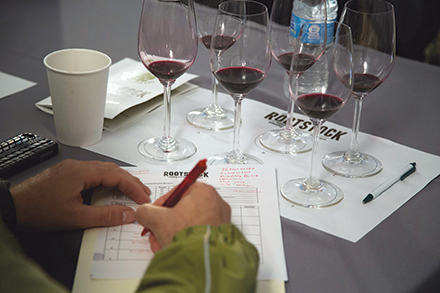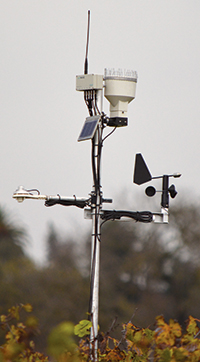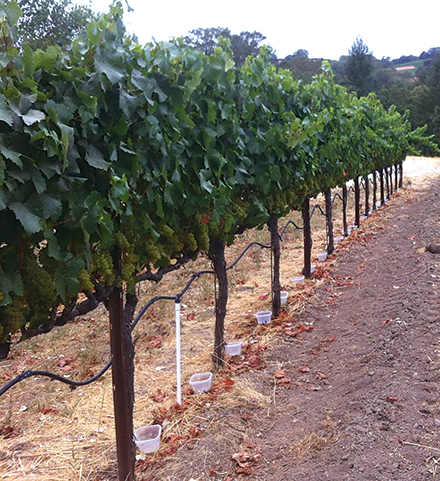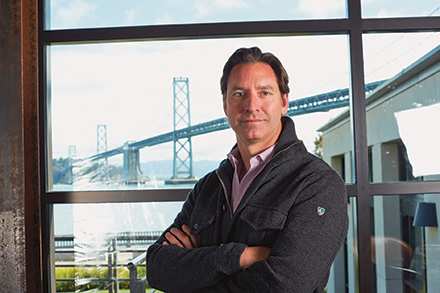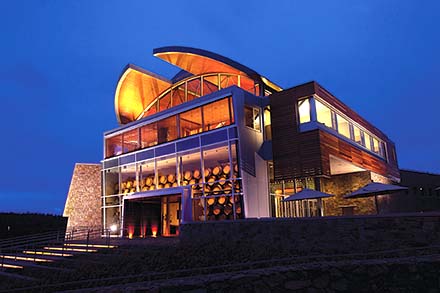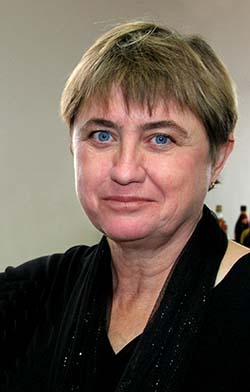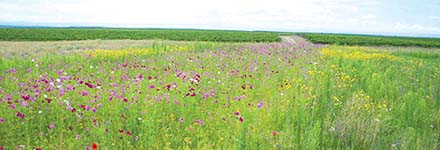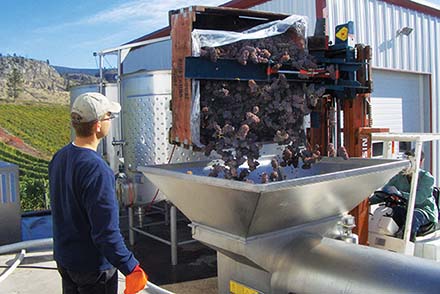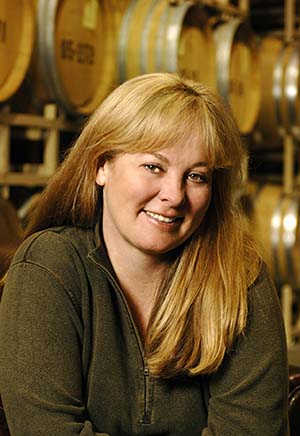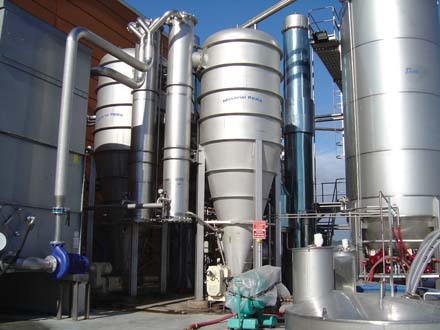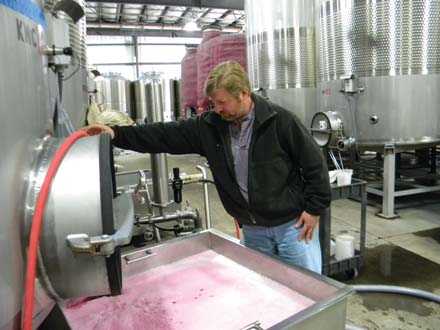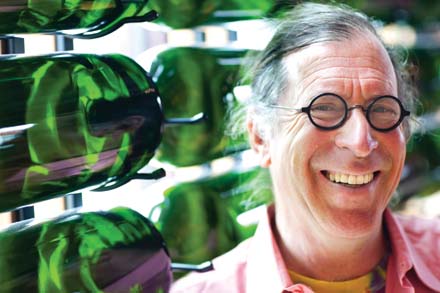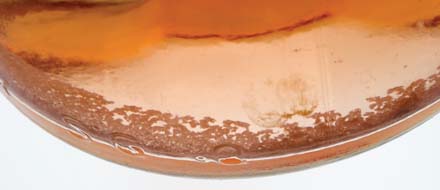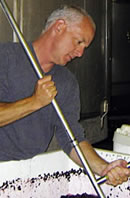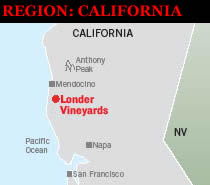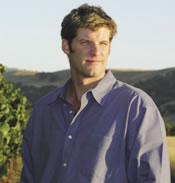
Growing & Winemaking
by Patrick L. ShabamGrowing & Winemaking
January 2019The Limitations of the Winkler Index
The Winkler Index or Winkler Scale is a standard for describing regional climates for viticulture in the United States. Developed by A.J. Winkler and M.A. Amerine at the University of Cali-fornia, Davis in the first half of the 20th century, the index was constructed to corre¬late wine quality with climate, focusing on California viticulture. Wine-producing regions of California were broken into five climatic regions using heat summations above 50° F, or growing degree days (GDD). Heat summa¬tions are a way of looking at accumulated temperatures over a given time period. De¬spite the common usage of the Winkler Index, the classifications offer greater uncertainty than the system suggests.
An obvious drawback to the Winkler Index is the focus on temperature alone. Winkler’s groundbreaking resource “General Viticulture” notes the influence of “rainfall, fog, humidity and duration of sunshine,” but Amerine and Winkler’s work and subsequent research found that temperature plays the greatest role in the development of wine grapes. As the focus of Winkler and Amerine’s wine-grape research was on California viticulture, their climatic regions had the luxury of ignoring precipita¬tion, as little rain falls during the growing season. Indeed, Winkler et al. in “General Vi¬ticulture” suggest that the vinifera grape “is not suited to humid summers, owing to its suscep¬tibility to certain fungus diseases and insect pests that flourish under humid conditions.”
Advances in viticulture have expanded the range of successful commercial vinifera pro¬duction, while more recent research notes the importance of wind on photosynthesis rates. Winkler et. al. also point out the importance of ongoing refinement of local variations, stat¬ing, “It is hoped that refinements will be de¬veloped so as to delimit subregions within the present regions, thereby ensuring the greatest potential for quality when the most favorable climatic subregion for a given variety is planted to that variety.”
Therefore, the Winkler Index was designed at a state scale, and not necessarily intended for smaller viticultural subregions or single vineyards.
READ MORE »
Growing & Winemaking
January 2019Reflections from a 50-year Vineyard Meander
I was flattered when I was invited to contribute to the final issue of Wines & Vines, commemorating 100 years of distinguished service to the American grape and wine sector. As an older member of the viticultural science fraternity, I have seen many changes in my 53 years working in vineyards, and I will comment on some of these here. I have been involved in research, teaching and consulting in more than 35 countries and many wine regions of the world, so I can offer some sort of international perspective.
A vital element of a successful grape and wine industry is communication between members, especially of technical information. To go back 50 years, this was largely the pur¬pose of trade magazines such as Wines & Vines. I recall that when I began my career, I was a devout reader of the Australian equivalent. Now trade meetings are more fre¬quent, and there are many other sources of information, but the printed word still has an important place. Trade magazines remain an important information source, and most grape and wine scientists still use them to get their message out to in¬dustry practitioners.
Another important American legacy is the American Society for Enology and Viticulture, which has spawned similar societies in Australia, South Africa, New Zealand and Japan. Well done, ASEV.
While I was born in Australia and spent much of my life there, I have been a frequent visitor to the United States over my profes¬sional career, for education, speaking engagements and con-sulting. I have visited most grapegrowing states of the U.S. To my mind, the United States and Australia have been im¬portant countries so far as technical improvements in viticulture have been con¬cerned, some of which I ac¬knowledge here.
I wondered about a relevant approach to this historical review and decided on a classification of “what had changed” in this period from 1966 to 2016, and “what has not changed,” some of which maybe should have! After I wrote this column, I came across Cliff Ohmart’s colum in the August 2018 issue of Wines & Vines, “Twenty years of sustainable winegrowing,” where he took a similar ap¬proach. Some of our conclusions are similar.
I wonder if there may be another period of 50 years with more changes than have occurred over the period of, say, 1966 to 2016, which I am discussing. I am no historian, and maybe others will comment, but it seems to me this has been a period of very substantial change. The following entries are listed in no particular order, but I would hope that some of the more significant from a global point of view are included higher up on the list.
Irrigation
READ MORE »
Growing & Winemaking
January 2019Grapegrowing Interview: Jordan Wente and Nikki Wente
For this Collector’s Edition of Wines & Vines, we thought that a youthful perspective from family members of the oldest continuously operated family-owned winery in the United States would be appropriate. Sisters Jordan Wente and Niki Wente are the youngest family members now involved in running Wente Family Es¬tates, a 750,000-case winery and dining, golfing and concert destination founded in California’s Livermore Valley in 1883.
Jordan, whose title is fifth-generation winegrower and project manager, procurement, joined the business in 2015 and has worked in project management and supply-chain roles. Currently she supports ongoing custom- and private-label projects. She earned a B.A. in political science from the University of Colorado, Boulder, and an MBA from California Polytechnic State Univer-sity (Cal Poly) in San Luis Obispo.
Niki, whose business card says fifth-generation winegrower and viticulture supervisor, joined the business in 2017 and now manages the buy¬ing and selling of grapes and winegrower rela-tions. Niki graduated from Cal Poly in June 2014 with a B.S. in wine and viticulture. One of her interim jobs was a role in grower relations and viticulture at Napa-based Huneeus Vintners.
Both are daughters of Phil Wente, who with his sib¬lings Carolyn Wente and Eric Wente are the senior members of the family ownership structure. Jordan and Niki are first cousins of Karl Wente and Christine Wente, who have been involved with the family business for about 15 years. The sisters sat for the interview at the Wente winery on Tesla Road in Livermore on Oct. 15, 2018, when their grape harvest was about 40% finished.
Q: What’s it like to be the youngest family members working at a 135-year-old family winery? Do you feel pressure?
Jordan Wente: Really there is not a lot of pressure on us. Our family has always shared so much and developed us so much that it’s a really comforting feeling to have that support. You never feel like you are under a ton of pressure, or at least I don’t. Because I know that they’re there to coach me and to teach me and grow me and support me.
Niki Wente: For me, I think that it is a lot of pressure. I’ve worked at other businesses in the wine industry, and coming back here I feel a lot of pressure that I really want to perform well, and I want to make this a wonderful place to work for everyone around me as well as kind of continue to move forward in this industry. But we have such a good support system. I call my dad almost daily and can talk to him about any issue we’re going through in the vineyards. He’s there to listen and talk me through it. It’s never an overwhelming pressure. It’s more of an exciting thing, because I’m excited to come to work every day. I want to see us succeed. I want to see my kids have the op¬portunity or option to come here and work.
READ MORE »
Growing & Winemaking
November 2018Domestic Sparkling Wine Finds Its Identity
While many in the wine trade consider Champagne the “king of wines and wine of kings,” more consumers increasingly regard sparkling wine as its equally regal offspring.
READ MORE »
Growing & Winemaking
August 2018A Conversation with Joe Dobbes
Winemaker Joe Dobbes grew up on a farm in Oregon's Willamette Valley, where he raised marionberries, a type of blackberry. His father, a doctor, was also a home winemaker, and young Joe liked to spend his time in the kitchen, developing his interest in diverse flavors.
READ MORE »
Growing & Winemaking
June 2018Cold Stabilization and Malolactic Fermentation
Two products that could help winemakers produce significantly better wines should prompt wineries to seek approval from the Alcohol and Tobacco Tax and Trade Bureau (TTB), which has not fast-tracked these items.
The first is Zenith, a colloidal material that will cold-stabilize both white and red wines permanently. Enartis developed the product and introduced it at this year's Unified Wine & Grape Symposium.
The second is a bacteria, Lactobacillus plantarum, that can consume malic acid to finish malolactic fermentation (MLF) more quickly and completely and with fewer side metabolites. L. planetarium is approved internationally for use in wine and in the United States for beer, but not for wine.
Zenith Uno and Zenith Color
READ MORE »
Growing & Winemaking
June 2018Producing Cabernet Wines at Different Price Points
Cabernet Sauvignon is the most popular red varietal wine with consumers and critics and the grape is expected to soon surpass Chardonnay as California's leading wine grape variety by tonnage and acreage.
In light of the varietal's dominance, four different Cabernet wines at four different price points were dissected in a tasting and panel discussion at the Unified Wine & Grape Symposium earlier this year. The session included presentations by the vineyard manager and winemaker responsible for four wines.
Moderating the session was Chris Munsell, director of winemaking for E. & J. Gallo Winery's premium wine program. Munsell said when he "was a wee lad in the winemaking world" a marketing executive told him for any wine to be successful it needed to be of good quality, known by consumers and profitable for everyone involved.
He said no other varietal or red blend has received as many 100-point scores as Cabernet Sauvignon and its popularity and profitability are obvious by the grape's place in the wine industry. When Munsell was introducing the panel he said he would not be surprised if Cab had outpaced Chardonnay in terms of total
production in the 2017 vintage, but when the California crush report came out about a month later, Chardonnay had held on to its top spot, barely. Growers harvested 614,565 tons of Chardonnay and 601,473 tons of Cabernet. Both varieties had a 14% share of the state's total wine grape harvest.
"Cabernet Sauvignon is also in a unique position where you see wines from from 7 to 8 bucks a bottle all the way up to 700 or 800 bucks a bottle and everything in between. Very few other varietals have that scope," Munsell said.
At $13 consistency is key
READ MORE »
Growing & Winemaking
May 2018How Wineries Take Advantage of Big Data (or Any Data)
Are the winemaking and sales decisions in your winery data-driven? Are all of your data sources well integrated into one system? Ask the question of some winery owners, and you may get these responses:
• "I will use data to run my winery once a really well-known Napa Valley winemaker does it and gets a98-point score. It's the wine industry, where everyone strives to be the first one to be the second one."
•"My winery prides itself on making wine exactly the way they did in France in the 18th century. I evenhave my tasting room staff wear Les Miserables costumes at work, and on weekends when we have bigcrowds, I make them sell their teeth just like Fantine did. The tourists love it!"
• "Data analysis is what the 'big guys' do, but not here. We're just farmers."
• "Wine is an art."
True, I invented the quotations above, but they're not as far-fetched as you might think. Data is generated at every step in the winemaking process, from soil moisture to vineyard sampling to weight tags to all steps of winemaking to case goods to sales to consumer data. We are buried in data, yet we often make important decisions on anecdotes and "gut instinct." Everyone has a story of an owner saying more or less, "I love our Gold Digger's Reserve, named after my last three wives. Sure, we only sell 173 cases every year, but let's keep making 1,000 cases."
Marshall Graves is a vice president and wine industry specialist at Bank of Marin. He encourages wineries to "go beyond using your data set to simply resell to existing customers. Aggregate and examine your data to obtain a precise understanding of what your club members enjoy beyond wine."
Graves suggests accomplishing this by collaborating with companies that specialize in data analytics and social physics. "Done well, this will improve wine club retention and ultimately result in wineries having a more efficient and cost-effective marketing strategy." He added that "each of the top five wine-producing states also have established technology hubs. Those who engage in conversation with their tech community will become agents of change vs. being the disrupted."
We all know we need to use data better, but turning it into something that objectively drives decision-making is a challenge for nearly everyone. I interviewed representatives of two wineries and their data vendors who are successfully integrating and using data in their everyday operations.
DRY CREEK VINEYARD
READ MORE »
Growing & Winemaking
April 2018Seeking Perfection in Pinot Noir
If the devil is in the details, then Pinot Noir makers comprise an unholy lot. Pinot Noir cuts a cruel swath through winemakers who may be inattentive, ill-informed or uninspired.
READ MORE »
Growing & Winemaking
March 2018A Conversation With Randy Heinzen
Andy Heinzen set out to become a computer engineer when he enrolled at California Polytechnic State University in San Luis Obispo. But the Gilroy native, whose family had farmed in California’s Salinas Valley for generations, realized that he would never leave his cubicle with that degree. So, he switched to political science, with an eye toward advocacy for the wine industry. When Cal Poly added a minor in enology and viticulture, he signed on to that program, too, graduating in 2000.
READ MORE »
Growing & Winemaking
February 2018How Semillon Grapes Adapt to Botrytis
Every year, winemaker Greg Allen waits as Napa Valley Sémillon takes its sweet time to mature. His staff and a team of researchers from the University of California, Davis, have demonstrated that grapes from John’s Creek vineyard are as hard at work in early November as the Far Niente field crew gearing up for late harvest.
Part of the 11,000-acre Coombsville sub-AVA, the 17-acre vineyard straddles some of what’s left of a volcanic vent that collapsed under its own weight 5 million years ago. The crescent-shaped caldera borders the Napa River to the west, the Vaca Range to the east and Mount George to the north.
Warm air rising from the valley floor draws coastal fog off the San Pablo Bay, moderating daytime temperatures and fueling a seemingly endless summer of misty mornings, warm days and moist nights. A temperate autumn extends the vintage, lengthening hang time and delaying harvest.
The valley’s maritime climate, hillsides that block the wind and trap humidity, and well-drained, nutrient-poor soil make the grapes ripe for Botrytis cinerea. Unlike bunch rot, which saps life from vines under a swath of moist mid-summer air, noble rot enhances the aromas, color, flavors and texture of wine made from late-harvest grapes, such as Far Niente Dolce.
By late fall, the grapes have ripened. Botrytis, a fungus that overwinters in the soil and on the vine, has drained moisture and nutrients from the infected berries and is rewriting the sensory profile of Sémillon grapes.
“Noble rot reprograms berry development and metabolism,” says Dario Cantu, plant geneticist and professor from the Department of Viticulture and Enology at UC Davis. “The interaction of the fruit and fungus stimulates metabolic pathways otherwise inactive in white-skinned berries, leading to the accumulation of additional compounds and creating the unique flavor and aroma of botrytized wines.”
When conditions are right—still air, high humidity, light rain and air temperatures that range from 58° to 82° F—the velvety gray fungus penetrates cracks in the cuticle of the grape, softening and dehydrating the berry. Threadlike hyphae trigger the nuclei of host cells to express genetic traits that redefine the sensory attributes for late-harvest wine. The sugar, acid and trace minerals that the mold leaves behind help define its character.
Sweet idleness
READ MORE »
Growing & Winemaking
January 2018How to Prepare for the Next Disaster
There is little to add to the reporting about the firestorm that struck Mendocino, Napa and Sonoma wine country Oct. 8, 2017. It was unlike any other disaster to hit California. Within a few hours, 21 separate fires started, whipped by 50- to 70-mile-per-hour winds that increased in velocity as the conflagration quickly grew. From CalFire we learned that the Tubbs Fire burned more than 5,300 structures, making it California’s most destructive wildfire ever. The 1991 Oakland Hills fire is a distant second at 2,900 structures lost. Three additional fires started that night are among the 20 most destructive blazes in California history: the Nuns Fire (No. 6), Atlas Fire (No. 10) and Redwood Valley Complex (No. 16).
READ MORE »
Growing & Winemaking
January 2018Fruit Flies Play Role in Sour Rot Complex
Sour rot is a term that is widely and somewhat inexactly used to refer to a group of late-season bunch rots that are particularly problematic on tight-cluster or thin-skin grape varieties. In California, it is another name given to a complex of fungal species and other microorganisms often referred to as summer bunch rot, which is reported to begin attacking berries when they reach a maturity stage corresponding to 8° Brix.
READ MORE »
Growing & Winemaking
January 2018A Conversation with Josh Jensen
World-class Pinot Noir from California seemed an improbable goal back in 1975, when Josh Jensen planted his first vineyards at Calera Wine Co. Jensen, a California native, had spent a couple of harvests in Burgundy in the early 1970s, and the place and its wines were a revelation to him.
READ MORE »
Growing & Winemaking
January 2018Tooth Care for Wine Professionals
Tasting the fruits of one’s labor is one of most rewarding parts of being a grapegrower or winemaker. However, it can also be an occupational hazard, with a greater predisposition among winemakers and wine judges to experience premature gum recession (from harsh tooth brushing), tooth erosion, tooth sensitivity and dry mouth due to greater and more frequent exposure to the acids present in wine. This article addresses some of the dental issues relevant to wine industry personnel as well as preventative measures that should be taken when tasting large numbers of wines in situations such as wine shows.
READ MORE »
Growing & Winemaking
January 2018Traminette's Popularity Spreads Across the East
Traminette, an aromatic grape related to Gewürztraminer, has become a popular variety in 19 states. First named in 1996 by the New York State Agricultural Experiment Station (NYSAES), the variety has experienced widespread growth from the East Coast to as far west as Missouri. It is very popular in New York’s Finger Lakes region and has been named Indiana’s “signature grape variety.” In addition, it was named Outstanding Fruit Cultivar by the American Society for Horticultural Science in 2015, the fourth NYSAES-bred fruit cultivar and the first grape to be so honored. Much of Traminette’s background information presented here was provided by Dr. Bruce Reisch at Cornell University and Dr. Bruce Bordelon at Purdue University.
READ MORE »
Growing & Winemaking
December 2017Future Farm Expo: Agriculture Interconnected
This August, I was fortunate to attend the Future Farm Expo in Pendleton, Ore. Following the theme of “Agriculture Interconnected,” there were speaker sessions focused on field robotics and automation, ground sensors, crop imagery, data use, precision irrigation and more.
The expo addresses the fundamental issue that farms must significantly improve productivity if the Earth is going to be able to feed 2 billion more people by 2050. At the same time, physically demanding and/or dangerous jobs are being eliminated. Grape presses were once hand-cranked, which is fine if you don’t mind hiring (and probably having to feed) a number of beefy employees and can live with leaving 25% of the juice behind. Coal mining is no longer done with a pick and shovel; instead, entire mountaintops are removed with explosives and massive pieces of equipment—a safer (though environmentally disastrous) and more efficient method that requires very few employees.
Beyond the global picture, the grape industry faces these challenges:
READ MORE »
Growing & Winemaking
December 2017Probing Nutrient Needs of Pinot Noir Vines
Seasonal uptake from the soil and use of nitrogen in grapevines has been examined in studies from numerous grapegrowing regions.1-3, 5-11 Uptake of other macronutrients including phosphorus, potassium, calcium and magnesium has received less attention,4,9,11 and no published study has determined the timing or quantities of micronutrient uptake of manganese, boron, zinc or copper for field-grown grapevines.
The majority of total seasonal nutrient uptake from vineyard soils (mainly for nitrogen) has been reported to occur between bloom and véraison in most studies on wine grapes (Vitis vinifera) and Concord grapes (Vitis labrusca) coincident with the increase in total vine biomass.2,3,5,6,7,9 However, some studies of wine grapes have found greater nitrogen uptake from vineyard soils between bud break and bloom than between bloom and véraison,1,8,11 even though the bulk of total vine biomass increase still occurred between bloom and véraison.
The majority of phosphorus uptake occurred early in the growing season (close to the time of flowering) in Pinot Noir,11 while the uptake for potassium, calcium and magnesium has mostly been reported between bloom and véraison.4,9,11
Given the differences observed in nutrient uptake of whole vines from previous trials, the nutrient uptake of young Pinot Noir vines was studied to provide growers with better information about the nutrient needs of young vines and when nutrient uptake occurs to provide better guidelines to manage nutrient inputs for young vineyards.
Key finding: Nutrient uptake and remobilization varies by specific nutrient
READ MORE »
Growing & Winemaking
December 2017How I Learned to Stop Worrying and Love the Drone
I recently acquired a new hammer, in the form of an aerial drone, and have been using it to hover over vineyards to look for nails. I have found many “nails” in the process.
I, drone: Separation of concerns
READ MORE »
Growing & Winemaking
November 2017A Conversation with Aron Weinkauf
Spottswoode Estate in St. Helena, Calif., is a Napa Valley classic: Wine grapes were first planted there in 1882. The current estate was established by Jack Novak and his wife, Mary, who started out as grapegrowers. Following her husband’s death, Mary Novak (who died last year) founded the current winery, 100 years after grapes had first been planted there. The collection of buildings dating from the 1880s exude a sense of history.
Spottswoode celebrates tradition, but it has not been bound by it. The winery has been an innovator over the years. The Novak family has farmed the estate vineyard organically since 1985, and it was certified in 1992. More recently, Biodynamic practices have been introduced. The winery recently has been renovated, and state-of-the-art equipment has been added.
Supervising both vineyard and winemaking is Aron Weinkauf, who has been with Spottswoode since 2006, when he became assistant winemaker under Jennifer Williams. Weinkauf, who graduated in 1999 from Berry College in Georgia with a degree in Spanish, developed an appreciation for wine while studying in Spain. When he returned to the states, Weinkauf enrolled in the viticulture and enology program at California State University, Fresno, and graduated in 2005. He worked at Ficklin Vineyards and Paul Hobbs before joining Spottswoode.
Weinkauf developed a deeper interest in viticulture at Spottswoode, and he became vineyard manager (in addition to his winemaking duties) in 2009. Two years later, he became the fifth head winemaker in Spotts-woode’s history.
Q: You’ve been using an optical sorter for several years. What are the advantages? Has it improved quality? Are there any disadvantages to using it?
READ MORE »
Growing & Winemaking
October 2017What Bottle Weight and Label Copy Convey
If it seems like the use of heavy bottles is increasing, that’s because it’s true. Rich DuBois, product manager for M.A. Silva and one of the industry’s most knowledgeable packaging professionals, told me just that. During the recession in 2010-11, the use of eco-friendly lightweight bottles (those weighing 450 grams or less at 750 ml capacity) peaked. Since then, the use of heavier glass (600 grams or more) has increased. Wineries that have moved to heavier glass are staying with it, because it’s working for them.
To categorize glass by weight and cost, DuBois gives this guidance:
READ MORE »
Growing & Winemaking
October 2017Best Practices for Gas Management at Bottling
Total package oxygen (TPO) management at bottling is crucial to avoid wine oxidation. According to bottling audits performed around the world, average TPO is 3 parts per million (ppm). This one-shot addition of 3 ppm at bottling may seem rather small, but when compared to what a closure brings per year—1 mg of oxygen in the case of a Nomacorc Select Green 100, for example—this potentially corresponds to three years of shelf life. It is important to take good care of TPO and develop strategies to control it in a consistent manner across the bottling process.
Both dissolved oxygen (DO) in the wine and headspace oxygen (a function of oxygen percentage in the headspace and headspace volume), when combined, are the definition of TPO.
How can low TPO be achieved? A key point is to measure O2 regularly at different bottling steps. Measuring TPO regularly is the only way to accurately quantify critical oxygen pickup and identify TPO variations during the process. The most recognized way to measure it is to use the NomaSense O2 P300 analyzer and a piercing system designed to facilitate real-time TPO measurements.
Based on hundreds of bottling audits performed around the world, we developed a specific quality-control approach both on gas-management and bottling-line settings in order to help wineries achieve best-in-class bottling practices.
Start with a low dissolved oxygen concentration in wine
READ MORE »
Growing & Winemaking
October 2017Regional Typicity of Cool-Climate Rieslings
The word Typicity is guaranteed to start animated discussion among sommeliers, wine educators and beverage directors alike. It is commonly used as a positive attribute when discussing varietal or regional wines, but it’s difficult to reach a consensus over how typicity is defined or achieved. Is typicity reflective of that other troublesome wine word, terroir? Differences exist between a Riesling produced in the Finger Lakes (FLX) AVA and one produced in Alsace, but what these differences are and who is qualified to evaluate them seems to change each time the question is posed.
While typicity and terroir are important concepts in wine quality, they have been hotly debated and poorly defined since the beginning of wine evaluation. The French designation Appellation d’Origine Contrôlée guarantees the quality of wine produced in a specific region, with sensory and chemical markers reflecting its geographical environment. This AOC designation, along with winemaking practices, are believed to generate a product that is typical, or representative, of its terroir.1
Though there has been a recent shift in the sensory community to make wine evaluation more objective, variations in wine-production methods, vineyard conditions and wine evaluators produce mixed results in studies seeking to tie aspects of terroir with typicity. In a 2009 study, Lucie Perrin and Jerome Pagès concluded that appellation alone was not sufficient to determine the sensory attributes of a wine from a specific appellation, due to high variability between wines of the same region. When Perrin and Pagès took these wines and compared them on the global scale, however, using the Napping method, the results were closely correlated with appellation.2
Studies in Burgundy headed by Le Fur3 and Ballester4 reframed the contrast of wine origin and wine typicity by comparing product space (e.g., Chardonnay wines from Burgundy) with sensory space (i.e., wines that experts felt typified Burgundian Chardonnays). With these two examples, sensory space and product space have a lot of overlap but are not identical. In Le Fur’s experiment, for example, Burgundian Chenin Blanc and Melon de Bourgogne were often ranked as “very typical” of Burgundian Chardonnay, and shared sensory space but not product space. Such overlap is expected in any exploration of regional wine typicity and can be used to help define expert and consumer perceptions of “typical” wines.
In the Finger Lakes region of New York, Riesling is unquestionably king, and regional experts of all sorts—producers, retailers and die-hard local fans—all can tell you what a “typical” FLX Riesling is. Dry, with notes of apricot and lime zest? Semi-sweet, with luscious fruit? There’s not necessarily agreement among local experts, which is problematic when the industry poised to send a flagship product out into the global market.
Typicity is generally defined by groups of experts who come to agreement over years of tasting. If the local experts don’t do it, typicity will be imposed by writers, sommeliers and tastemakers from the broader wine world. This raises several questions: Can an emerging wine region shape public notion of their own typicity? Should they? And do “experts” even experience wine the same way that their regular customers do?
Sensory evaluation study at Cornell
READ MORE »
Growing & Winemaking
September 2017Evolving Styles for Marquette Wines
To oak or not to oak? That is the question facing many Marquette producers as the promising cold-climate grape comes of age. While vintners initially relied heavily on traditional oak treatments for red wine in general and hybrids in particular, many of them have found that less is more. Hybrid barrels, oak staves and oak spirals have become much more widely utilized.
With few exceptions, winemakers across the northern tier of states have moved toward letting the grape, first released in 2006, express its own particular style and attributes. Even one of the grape’s progenitors has curbed his oak program for Marquette.
“We have been evolving at Saint Croix (Vineyards in Stillwater, Minn.),” said Peter Hemstad, who helped develop the grape at the University of Minnesota and has been making Marquette longer than anyone. “We traditionally have made it in a heavy style, pretty extracted and pretty heavily oaked in barrels for more than a year. In recent years, we decided to dial it back a little.
“Even if you make it with no oak, it’s an appealing wine with complexity. I think oak complements it, and I also think the marketplace now appreciates a little less oak than we made it with originally,” he added.
After using American oak for years, Hemstad and his winemaker, Martin Polognioli, now use a mix of new, one-year-old and two-year-old hybrid barrels with French heads and American staves. They’re sourced from two Napa-based outfits—primarily World Cooperage with a few from Seguin Moreau.
At Lincoln Peak Vineyard in New Haven, Vt., Chris Granstrom has followed a similar path but moved even further away from new oak. He started off using new American oak barrels. “If you’re a new winery, you get a lot of new barrels,” he said with a chuckle. He now employs mostly “a French-American hybrid barrel with a few years on it,” with about 15% new hybrid barrels from World Cooperage.
At February’s Cold Climate Grape Conference, Granstrom told a gathering, “I’m not sure that the right amount of oak for Marquette is zero, but it’s pretty close to zero.” In a recent phone interview, he elaborated: “The only reason I can say that is that I’ve tasted a lot of Marquette, and a lot of it is over-oaked.
“Marquette has a lot of flavor, and a spicy thing going on. But for whatever reason, all that uniqueness gets squelched (by new oak), and it tastes like just another oaky red wine,” he said. “I think it’s especially prone to too much American oak, because the vanilla really dominates Marquette.”
Whatever Granstrom is doing is working: Lincoln Peak’s Marquettes have won a raft of gold medals at competitions as well as a Best in Show for Red Wines award for its 2013 Marquette at the 2015 International Cold Climate Wine Competition.
Other oak sources
READ MORE »
Growing & Winemaking
September 2017Winemaker Interview: A Conversation with The Corley Family
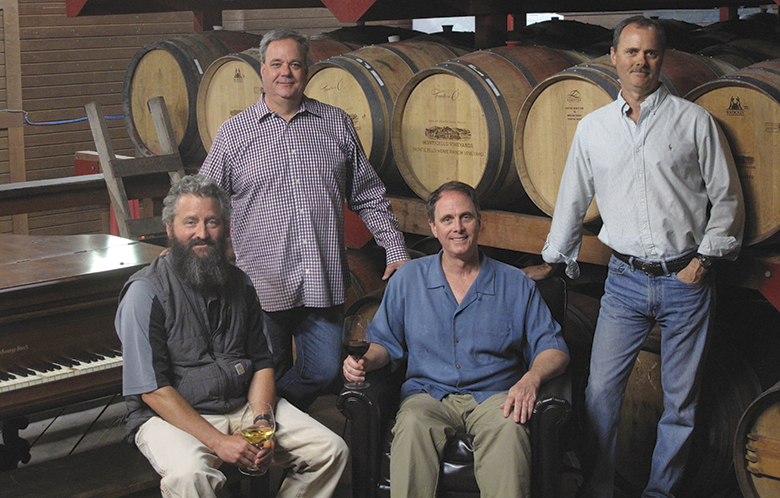 Chris (from left), Stephen, Kevin and Kent Corley all handle different aspects of their family-owned wine business.
Chris (from left), Stephen, Kevin and Kent Corley all handle different aspects of their family-owned wine business.When Jay Corley was studying for his master of business administration degree at Pepperdine University in Malibu, Calif., his thesis was about starting a vineyard and winery business. After spending a few years on successful business ventures in Southern California, he decided to put that thesis into practice.
READ MORE »
Growing & Winemaking
August 2017How Wineries Choose Their Closures
In 1999, two major synthetic cork brands were launched using a new extrusion technology that is still the standard in the industry. After 18 years, synthetics have roughly 20% of the wine bottle closure market. Screwcaps, too, are estimated to have as much as 20% market share, while other alternatives such as technical corks that combine fine cork particles, microspheres and glue are growing steadily as well. Alternative packages such as cans, kegs and bag-in-box also are growing. For the wine industry, this much change in 18 only years is considered “disruptive technology.”
By comparison, other industries innovate just a little more rapidly. In 1999, Dell Computer launched its top-of-the-line Latitude R400GT notebook computer featuring a battery life of two hours, 64 MB RAM, 6.4 GB hard drive, a CD-ROM drive, and weighing only 7.4 pounds for $3,098. Today, we can buy a much faster, lighter laptop with a better screen for about $600.
In 2017, we know all the wine closures I mentioned are commercially and technically acceptable. We also know that wineries have their preferences and opinions, which are based on their own experiences.
I interviewed five wine industry decision makers—winemakers, winery owners and a marketing manager—from coast to coast to learn why they use what they use to seal wine bottles. The five wineries represented make wines in a wide cross-section of styles, price points and locations, and target them to vastly different consumer groups.
Closure certainty for luxury wines
READ MORE »
Growing & Winemaking
July 2017A Conversation with Scott McLeod
Winemaker Scott McLeod, a native of Marin County, Calif., got interested in fermentation when he tried his hand at making beer while he was in high school. That interest took him to the University of California, Davis, where he graduated in 1985 with a degree in fermentation science.
While he was studying at Davis, McLeod spent a year at Isole e Olena in Chianti Classico, and he returned to the Italian wine region after graduation to work for another year at Badia a Passignano. When he returned to California, he bounced around the Napa Valley, working for several wineries, until winemaker Tony Soter introduced him to Francis Ford Coppola. Coppola hired McLeod in 1991 to make the wines at his Napa Valley estate, then known as Niebaum-Coppola. As director of winemaking, McLeod made the estate wines, including the flagship Rubicon Estate red, and oversaw wines such as the Diamond Series bottlings.
After 18 years working for Coppola, McLeod struck out on his own in May 2010. He’s a partner in WineXRay and Safe Harbor Wine Storage, both in Napa. He’s also the winemaker for George Lucas’ Skywalker Vineyard in Marin County as well as consulting winemaker for Daou Vineyards and Parrish Family in Paso Robles and Monte Xanic in Mexico’s Guadalupe Valley. McLeod also consults for several other winery and vineyard projects and is a partner in 180 acres of vineyards in El Dorado and Monterey counties.
QOne of your ventures is an analytical service in Napa called WineXRay. Please explain what sort of analysis you provide.
READ MORE »
Growing & Winemaking
June 2017Self-Assessment Workbooks: Where Are They Now?
It has been 20 years since the first self-assessment workbook about the sustainable production of wine grapes was published in the United States. Since then, self-assessment workbooks have been written for and used by wine grape growers in California, Washington and New York, and by juice grape growers in New York, Michigan and Pennsylvania. Their use has had a significant influence on sustainable winegrowing programs, practice implementation and sustainability reporting. No other U.S. agriculture sector has adopted the use of self-assessment as much as the wine and grape industry. Because of the workbooks’ widespread use and influence, I thought it would be interesting to contact the various programs using self-assessment workbooks to find out if use has changed over time and, if so, how.
But first, for those readers not familiar with self-assessment workbooks, they consist of a list of farming practices that a grapegrower reads and uses to record whether or not they are using the various practices. They can be used for reasons such as in education and outreach programs, encouraging growers to increase wine grape quality, stimulating them to continually improve, enabling groups to anonymously aggregate assessment results for use in sustainability reporting, benchmarking practice implementation and measuring wine grape-growing improvement over time. A great attribute they all share is that any and all growers can use them since they incorporate a broad range of wine grape-growing practices.
Beginning in the Central Coast
READ MORE »
Growing & Winemaking
May 2017Vineyard Management Following a Wet Winter
We are all delighted it finally has rained enough in most of California to end drought conditions. It was a long five years. In many regions, rainfall is 50% to 75% above average. Snowpack in the Sierra was 175% to 200% above normal by late March. On my property along the upper Russian River in Mendocino County, we had five flood events—a record in my lifetime! Most reservoirs are full around the state.
While we all enjoy having water again, the abundant rainfall can cause some profound effects in your vineyard.
Flooded areas
READ MORE »
Growing & Winemaking
May 2017Heading Toward the 'No-Touch' Vineyard
In a decade or less, a vineyard owner could “farm” by sitting in front of a monitor or, more likely, a smartphone or tablet.
Unmanned aerial vehicles, self-driving tractors with robotic implements and elaborate real-time monitoring systems could eliminate the need for human labor and turn into a reality the concept of the “no-touch” vineyard.
While it’s debatable when such a future will arrive, as agricultural labor continues to grow more scarce and more expensive, it’s undoubtable that more and more vineyard operations will be mechanized and eventually automated. The subject was the focus of lengthy sessions at this year’s Unified Wine & Grape Symposium in Sacramento, Calif., and the WiVi conference hosted in Paso Robles, Calif., by Wine Business Monthly. (Both Wine Business Monthly and Wines & Vines magazine are part of Wine Communications Group.)
The panel at Unified focused more on high-tonnage vineyards, but at WiVi vineyard managers for Jackson Family Wines and Treasury Wine Estates discussed how they’ve mechanized premium vineyard operations as well.
Speakers on both panels said there’s a need for more mechanization but stressed it isn’t yet a one-size-fits-all solution that can easily be brought to just any vineyard. “I truly do feel that what we talk about here today, we’re moving in the right direction,” Aaron Lange, the vice president of vineyard operations for LangeTwins Family Winery and Vineyards, which owns more than 7,000 acres of vineyards in the Lodi, Calif., area, said during Unified. “We will absolutely have a no-touch vineyard in five or 10 years. I truly believe it.”
A shrinking, aging labor pool
READ MORE »
Growing & Winemaking
April 2017Benefits of Egg-Shaped Wine Tanks
One of the latest trends in winemaking equipment involves the egg-shaped wine tanks that have found their way into many wineries. There is a great deal of myth surrounding the utility and functionality of these vessels. Since I used an egg tank last harvest, I decided to review the literature about how these tanks are being used and what a winemaker might expect if venturing into this “new” esoteric method of wine production.
READ MORE »
Growing & Winemaking
April 2017Grapegrowers Make Progress with Cold-Hardy Varieties
Growing cold-hardy grapes and making wine from them might be the ultimate lifelong learning process, if the sessions at the Cold Climate Conference held Feb. 16-18 in Bloomington, Minn., are any indication. But thanks to the work of researchers and educators, many of whom drew standing-room-only audiences for their presentations at the conference, the learning curve has gotten a little less steep.
READ MORE »
Growing & Winemaking
March 2017How Wineries Use Vineyard Technology
A Google search for the exact phrase “wines are made in the vineyard” produced 40,600 results, making it one of the industry’s mantras, along with “our Chardonnay is buttery” and “I thought we’d be cash-flow positive by now.” All overused, yet accurate.
Since much of winery success and wine quality is based on grape quality, I interviewed several winemakers and viticulturists about what they currently do in the vineyard to enhance wine flavor and assure consistency from year to year. They shared with me what data they collect, cropping levels, harvest criteria and advanced technologies employed.
Rodney Strong Vineyards
READ MORE »
Growing & Winemaking
March 2017A Conversation with Jim Barbour
Jim Barbour, one of the Napa Valley’s leading viticulturists, grew up on his family’s Rutherford vineyard. The Barbours grew Gamay, Mondeuse and Petit Bouschet that E. & J. Gallo Winery harvested for its jug wine program. They also farmed stone fruit and walnuts, but the future of the valley was wine grapes, so that became the Barbours’ focus.
The young viticulturist’s childhood chores focused on the farm, so when he went to college, he planned to try something new: being a parole officer. He quickly decided that wasn’t the career for him, however, so he went back to what he knew. He transferred to the University of California, Davis, and graduated in 1975 with a degree in plant science. While he was at Davis, Barbour would return home on weekends to drive a tractor for prominent viticulturist Frank “Laurie” Wood at Frank Wood & Sons. After graduating, he went to work for the company full time until Wood’s retirement in 1990. Barbour then started his own management company, Barbour Vineyards. In his 40-year career, Barbour has planted and managed some of the valley’s best and best-known vineyards and has worked with winemakers such as Celia Welch, Heidi Barrett, Philippe Melka, Aaron Pott, Thomas Brown and Martha McClellan. He currently manages about 500 acres of vineyards for various clients including Hundred Acre, Revanna, Jones Family, Checkerboard, Tietjen, Keever and Alejandro Bulgheroni.
In 1995, Barbour launched his own Barbour Vineyards wine brand, for which Welch is the current winemaker. The label produces 300 cases of dry-farmed Cabernet Sauvignon from Barbour’s 4-acre vineyard in southern St. Helena. Barbour is also a partner with Barrett and John Schwartz in Au Sommet, a project on Atlas Peak.
Q: What new vineyard technologies are you most excited about?
READ MORE »
Growing & Winemaking
January 2017A Conversation with Jared Brandt
Jared and Tracey Brandt of Donkey & Goat winery in Berkeley, Calif., were working for tech companies in the San Francisco Bay Area when they decided to take a one-year sabbatical in 2001. They loved wine, so rather than simply travel for a year, they went to France to study winemaking under Eric Texier, a respected winemaker in the Rhône Valley and Mâconnais regions who was committed to “natural” viticulture and winemaking.
READ MORE »
Growing & Winemaking
January 2017The Radical Reshaping of Babcock Vineyards
Since 2008, Bryan Babcock in the Sta. Rita Hills AVA of Santa Barbara County, Calif., has radicallyreshaped Babcock Vineyards using a new approach he calls “pedestular cane suspension” (PCS), which has reduced vineyard costs by 25%. Babcock coined the term “pedestular” to note the innovative use of metal pedestals that support and contain the vine’s fruiting canes and support the subsequent crop.
READ MORE »
Growing & Winemaking
January 2017Fifty Shades of Greywater
California is in the midst of an unprecedented water crisis. In 2014, the U.S. Government Accountability Office reported that 40 states expect water shortages during the next 10 years. To help, the recycled water movement is steadily flowing as vineyards search for new sources of water to be used for irrigation, frost protection, landscaping and other operations. A news item in the June 2016 issue of Wines & Vines highlighted a new water-conservation opportunity for the Carneros American Viticultural Area: receiving recycled water for vineyard and landscaping irrigation from the recently completed Napa Sanitation District’s “purple” pipes. (See “Recycled Water now an option for Napa Vineyards.”)
This article takes up where that one left off and discusses the feasibility and complications of incorporating recycled greywater into your vineyard, including the types of permits required, the use and discharge limitations, required monitoring and reporting, recycled water use agreements and, finally, where to seek funding. This is a practical introduction for wineries and vineyards to the convoluted, multi-layered pool of greywater reuse.
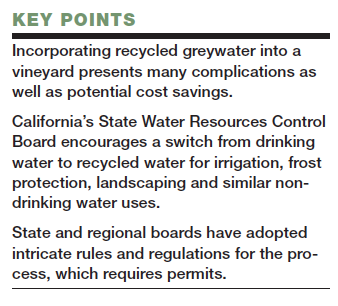 READ MORE »
READ MORE »
Growing & Winemaking
January 2017Start Planning Equipment Purchases Now
January in the winery. Harvest is in the rearview mirror, and wines are aging or getting ready for bottling. You had some time over the holidays to get reacquainted with your family and resume a normal sleep schedule. The last thing you want to think about is next harvest, but if you plan to buy new crush equipment, now is the time.
READ MORE »
Growing & Winemaking
December 2016Majority in Napa to Replace Vines by 2017
Napa, Calif.—Pressure from grapevine red blotch-associated virus and Pierce’s disease is one of the mainreasons most Napa County wine grape growers plan to redevelop vineyards by 2017.
READ MORE »
Growing & Winemaking
December 2016Researchers Dispute Theory About Low Yields, High Quality
Napa, Calif.—The universal rule about lower yields producing better wines has been pretty well debunked by scientists, but it hasn’t been accepted by all winery marketing personnel (and some winemakers) who insist lower yields equal better quality.
READ MORE »
Growing & Winemaking
November 2016Advances in Enzymatic Analysis Technology
I last wrote about several laboratory analyses testing for important wine and grape constituents using enzymatic protocols measured spectroscopically in April 2014. Since that time, Megazyme introduced a new spectrophotometer called the MegaQuant Wave.
In addition to this new entrant designed for small to medium-sized wineries, two other instrument producers are competing in this segment of the market. The instruments are discussed in the order of price of market entry; check with each manufacturer for their exact costs.
Prior to the introduction of purpose-built instruments, incidental users of enzymatic analysis had to use basic spectrophotometers. These instruments had significant limitations, not the least of which was that the user had to do the calculations by hand and use equations that many in the wine industry did not feel comfortable computing.
The harbinger of the effort to supply a purpose-built, small-format enzymatic analysis instrument for smaller wineries was the Monza analyzer from Randox. This instrument was featured in the April 2014 Wines & Vines article mentioned above. Astoria-Pacific, another company in this market area, has offered a larger format, purpose-built system for many years that is a step up in sophistication from the Randox Monza. It has an auto sampling system and is useful for wineries that have a higher volume of analyses on a regular basis.
In the past, the most cost-effective means of analyzing wine constituents using enzymes was to buy a simple spectrophotometer such as the Spec 20, originally produced by Bausch & Lomb but now sold by Thermo-Scientific. The key to this instrument’s operation was a diffraction grating that split the incoming light source into discrete narrow bands of light (10 nm or less) and measured by a photometer. This instrument was designed to study between 940 nm and 340 nm wavelengths of light. For many enzymatic analyses, the most
READ MORE »
Growing & Winemaking
October 2016Brand Differentiation Is the Key to Success
Bokisch Vineyards set itself apart through its ?dedication to Spanish grape varieties.The book Blue Ocean Strategy, authored by W. Chan Kim and Renée Mauborgne, makes this observation: “Today’s overcrowded industries competing head-on results in nothing but a bloody red ocean of rivals fighting over a shrinking profit pool. Lasting success comes not from battling competitors, but from creating blue oceans of untapped new market spaces ripe for growth.” Brands that are different can grow much more easily because their market is a big blue ocean.
This slogan from a paradoy motivational poster could have been written about the wine business: “Conformity: When people are free to do as they please, they usually imitate each other.” Common wisdom states that you must revere tradition and do things “the way the wine industry does it.” Yet many of the most successful California brands did just the opposite. Kendall-Jackson made its Chardonnay slightly sweet. Purists said the winery wasn’t making Chardonnay the “right way,” but brand-loyal consumers loved it. It has had enormous success. The point of differentiation could be a new varietal such as Bob Lindquist of Qupé pioneering Syrah in the 1980s, or a new appellation like Steve and Pamela Storrs’ dedication to the Santa Cruz Mountains.
What is your story, your mission? So often a winery’s “About Us” page reads like this: “It was the dream of wealthy corporate-types and wine lovers Jane and John Doe to someday plant a vineyard, build a winery and make hand-crafted, artisan wines. Several years later, that dream has come true, with our ostentatious winery building making the cover of Modern Narcissist magazine.” (OK, I made up that last part.)
While this prose appeals to the owners, it is unlikely to connect with consumers. They don’t react by thinking, “Oh, you’re already rich and always wanted your name on a wine label, I feel a connection! Sign me up for the 12-bottle wine club.” I would argue that if wanting to be in the wine business was your reason for being in the wine business, then you have completed your mission. The problem is your mission wasn’t focused enough on creating a differentiated business. It may be why your tasting room is empty, your wines aren’t selling and you are low on cash.
Every year I give a guest lecture about entrepreneurship to students in Napa Valley College’s wine program. I ask a few students to describe the winery where they work and its Chardonnay, if they make one. The first student says something like, “We’re a family winery, very dedicated to making great wine. We believe wine is made in the vineyard. Our Chardonnay is barrel fermented in the traditional French style.” The second earnestly explains, “I too work for a family winery, very dedicated to making great wine; our Chardonnay is barrel fermented, etc.” The third says essentially the same thing, maybe subbing Cabernet made in the Bordeaux style for Chardonnay. I then ask the rest of the class which one they’d buy. The answer is, “I don’t know, they all seem pretty good.” Regardless of wine quality, the brands are undifferentiated commodities to the consumer.
Let’s look at a few wineries that found success through brand differentiation.
A visit to Catalonia
READ MORE »
Growing & Winemaking
September 2016California Crop Forecast: 4 Million Tons
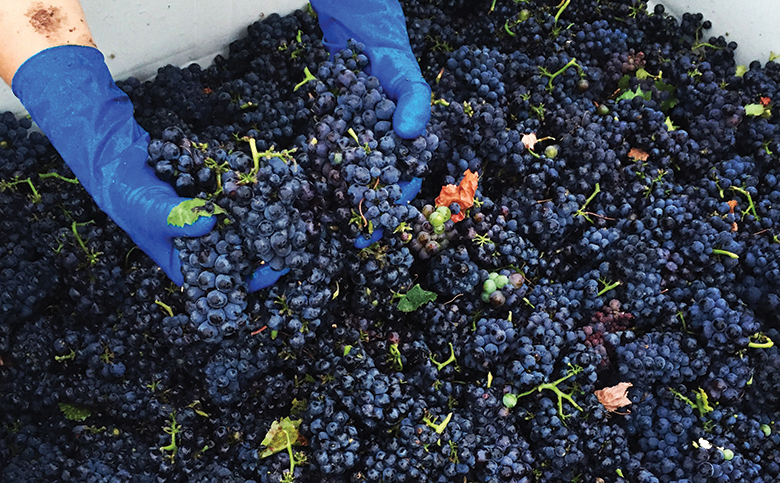 Credit: Ashley Urdang/Gloria Ferrer
Credit: Ashley Urdang/Gloria FerrerAllied Grape Growers president Nat DiBuduo believes that the 2016 crop “seems to be getting smaller,” to the tune of 4 million tons expected in California.
Speaking at the 64th annual meeting of the Allied Grape Growers in July, DiBuduo told the audience that while Allied Grape Growers is still compiling estimates, it appears total tonnage in California will be about 4 million tons. This is below “average” after a number of big years (excepting the short harvest of 2015), but it’s not clear what average is with new plantings producing higher yields.
Allied Grape Growers held events in the California cities of Fresno and Santa Rosa to accommodate the group’s members in both regions. Wines & Vines attended the meeting in Santa Rosa (in the North Coast), where Allied Grape Growers had roughly 1,500 acres under contract in 2010 and represents more than 2,500 acres today.
Unlike the 2015 meeting, this gathering was mostly upbeat. “Some years I would rather be having a tooth pulled than face you with the news,” said president and CEO Nat DiBuduo. “Last year was one of those years.”
Fortunately, things are going well for the grape marketing cooperative, which has nearly 500 members including 125 member-growers in the North Coast, 50 in Lodi/Clarksburg and Contra Costa County and 300 in California’s interior valleys.
Allied Grape Growers has members across the state, from southern Kern County up to Clear Lake in Lake County. So far this year, grapes have been contracted from $275 per ton to $7,500 per ton or higher, depending on location and variety, DiBuduo said. He disclosed that the co-op’s revenue for 2015 was more than $70 million.
In Lodi, the co-op has experienced more than 37% growth in wine grapes since 2010. There were fewer growers at the co-op’s Central San Joaquin Valley meeting; many pulled out their Thompson Seedless vines or sold their ranches, but wine grape acreage has still grown 50%.
DiBuduo admitted he received a lot of criticism at the Unified Wine & Grape Symposium in Sacramento, Calif., this January, when he suggested growers needed to pull out more wine grape acres.
“No wine grape grower should be providing grapes below their cost of production. You are in the business to survive and thrive. So if I can save any grower from going bankrupt by suggesting alternatives or getting better pricing, I will.”
He summarized the overall market for California wine grapes:
“North Coast is the shining star in this industry. The current demand is outpacing the supply. There are strong prices and terms. Some wineries are offering planting contracts for the first time in years.”
Central Coast prices appear to be strengthening. The supply is limited there. “We see some contracts for Pinot Noir and Chardonnay.”
DiBuduo said that, while it’s early in the season, Lodi growers are enjoying strong sales, and most grapes are finding homes. There is a limited supply available of red Zinfandel and some other varieties.
In the central San Joaquin Valley, however, some varieties like Muscat, Ruby Cabernet and white Zinfandel continue to be challenged. “We have plenty of those for sale,” he said. “The good news is that in August of last year, we had over 20% left to sell. This year we have less than 10% left.”
A push for ‘premiumization’
READ MORE »
Growing & Winemaking
August 2016California Law Regulates Piece-Rate Payers
A new California law that went into effect in January 2016 presents problems for employers who pay their workers piece-rate (rather than hourly) wages. AB 1513 requires companies to separate piece-work compensation from rest and recovery (R&R) breaks and other “non-productive” time on the job. Repayment plans were ordered to be in place by July 1.
Piece-rate compensation is popular with productive workers and with employers, especially in this era when skilled vineyard workers are in short supply and high demand in California.
Although statistics were not available, according to Tyler Blackney, director of government relations for the California Association of Winegrape Growers (CAWG), “A lot of people do piece work. A lot of workers like it. This law will make it more complicated. I don’t know how HR (human resources) people will track it.”
Blackney said that back pay would amount to six figures for some agriculture companies. Factoring in California’s recent minimum wage increase, “It will be hard for some vineyards.”
He stated: “This new piece-rate legislation is going to result in a number of our growers paying a substantial amount to avoid liability. Some are facing six-figure payments. That is a lot of money. Moving forward, piece rate is going to be used less frequently, because growers are not going to want to face the future liability for doing it wrong. It’s a shame because workers prefer piece rate: It provides them an option to maximize their profits over a shorter period of time.”
Grapegrower calls ‘foul’
READ MORE »
Growing & Winemaking
August 2016Closure Decisions Are More Than Technical
Eleven years of “cork wars” combat experience (I was founder and president of Neocork, a synthetic cork pioneer) gave me insight about closure decisions. It failed to give me wealth, just insight. I am rich with insight.
Some might say that having “a synthetic cork guy” write this story is like letting Elon Musk write an objective comparison of electric vs. gas vs. diesel cars. It’s been more than 10 years since I’ve worked for or had a financial stake in any closure company. I’d like to think that time has mellowed rather than “tainted” me (pun apology No. 1.).
When I started with alternative closures 22 years ago, one-piece natural corks were the standard, with twin-disk corks used for value-priced wines. Cork quality attributes were primarily cosmetic: A pretty cork was a good cork. A gorgeous cork was a great cork and cost more. Screwcaps were used on jug wines only. There were no acceptable synthetic corks that worked, plus they had a huge image problem. Winery owners and marketing directors were certain that the moment they sealed a wine with something other than tree bark, their wines would be immediately removed from every wine list and store shelf in the country—and worst of all, they’d personally be found guilty of the scandalous crime of breaking with the industry’s traditions of “how we do things.”
What I’ve learned over the years (and what Jane Firstenfeld’s article on page 36 confirms) is that no one closure type is the undisputed “winner,” nor are any of them fundamentally unacceptable. Around the world in the next 24 hours, several million screwcap-sealed bottles will be opened and enjoyed, as will several million bottles sealed under synthetic cork.
Focus on the consumer
READ MORE »
Growing & Winemaking
July 2016Winemaker Interview: A Conversation with Jeff Meier
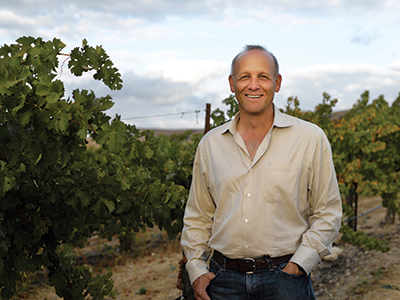
Winemakers are often peripatetic types, changing jobs every few years. Not Jeff Meier. The director of winemaking at J. Lohr Vineyards & Wines has been with the company (which has wineries in San Jose, Paso Robles and Greenfield, Calif., and farms 3,700 acres of vineyards) for more than three decades.
READ MORE »
Growing & Winemaking
July 2016Capitalizing on Winemaking Waste
Waste flows from the winemaking supply chain contain wastewater (generally treated inside the winery or sent to municipal plants via sewage systems or by truck) and solid waste such as stems, pomace and lees. In Italy the stems were traditionally used as soil amendments, while for years the pomace and lees have been delivered compulsorily to distilleries for the production of alcohol and the recovery of tartaric acid.
Regulation EC 479\2008 of the European Union introduced important new elements to the legal framework of the wine sector, offering member states the possibility of defining the end use of pomace. Italy implemented the above regulation by means of a ministerial decree, which, as an alternative to distillation, allows it to be collected under control for the recovery of enocyanins (anthocyanins responsible for the color of red grapes), the production of agricultural products (direct or indirect agronomical use), energy recovery (using byproducts such as biomass for the production of biogas or for fueling energy-production plants) and the extraction of molecules with a high added value for pharmaceutical and cosmetic purposes.
Direct agronomical use of these waste flows is a choice to be made under careful control and is inevitably subject to the dictates of legislation related to nitrates. In fact, it should be taken into account that the presence of polyphenols (antimicrobials), salts, heavy metals and nitrogen in these highly biodegradable wastes can compromise the quality of the receiving soil in the long term. Moreover, polyphenols inhibit germination and immobilize nitrogen in the soil.
Treatment of these wastes is fundamental, but it can be a significant cost for a winery. In fact, the high chemical and biological oxygen demand values highlight the high consumption of oxygen associated with their decomposition and therefore the risk of establishing conditions of anoxia in soils and rivers.
Biogas from anaerobic digestion
READ MORE »
Growing & Winemaking
July 2016The Hyde-Hobbs Partnership
Larry Hyde (left) and Paul HobbsA quarter-century ago, vineyard owner Larry Hyde and winemaker Paul Hobbs launched a partnership that inspired them to farm one of the first blocks of Hyde Vineyard Pinot Noir collaboratively. Hobbs agreed to pay Hyde for the grapes based on expected yield, not how much fruit he harvested. “If the crop looked too big and Paul wanted to drop fruit,” Hyde says, “he took the risk.”
But before the growing season began, Hobbs walked the vineyard in the Carneros district of Napa Valley with Hyde to determine which varieties and vineyard blocks he wanted to farm. According to Hyde, the agreement gave Hobbs and 40 other winemakers who signed similar contracts “leeway to grow exactly what they want.”
Together, Hyde and Hobbs carved a path to explore the character of the 152-acre vineyard that the Hyde family cleared in 1978 and planted in 1979. “I experiment with climate, soil and farming practices with every vintage,” Hyde says. “I learn something new from every producer, every variety, every year.”
For winemakers like Hobbs, Hyde returned the favor. “I was hungry for knowledge,” Hobbs says, “and sitting at Larry’s table was the place to be.”
Lay of the land
READ MORE »
Growing & Winemaking
June 2016It's OK to Plan: Preparing for Harvest
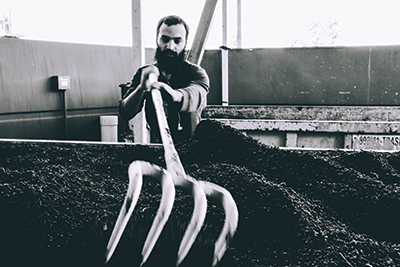 Hiring staff and ordering equipment and supplies well in advance of harvest can make the busy season (seen here at Herzog Wine Cellars) go more smoothly.
Hiring staff and ordering equipment and supplies well in advance of harvest can make the busy season (seen here at Herzog Wine Cellars) go more smoothly.Well, it’s June at the winery, which means you are probably getting ready to bottle some wines, finalize grape contracts and squeeze in a vacation before the madness of harvest begins. June is also an ideal time to plan for harvest. For many winemakers, planning for harvest means the following:
a. Spend a few hours online researching your vacation, checking out hotels, restaurants, tourist attractions, best places to fish, etc.
b. Walk through each of the vineyards that supply your winery. The typical two-hour visit is split into 30 minutes walking through the vineyard and actually assessing the vines and 90 minutes listening to the vineyard manager complain about how tough grapegrowing is this year, because it’s about the worst year he/she has ever seen for (insert vineyard malady or climate attribute here).
c. Make an unfounded tonnage estimate.
d. Remember that just as last harvest ended, you and your cellar crew made a “to-do list” for next year, vowing that 2016 would not be a repeat of “the great 2015 train wreck.” There was a list of spare parts needed, equipment that required major servicing, winery layout changes for better material flow and supplies that need to be ordered a lot earlier than you did.
e. Unfortunately, you pinned the to-do list to a corkboard, which has since been taken down. You now spend a few hours looking for it. You ask the cellar crew if they remember where it may have gone.
f. You give up on finding the to-do list. Rationalize to yourself that it’s not really that important. 2016 won’t be like 2015 because, well, just because.
g. Go back to planning your vacation.
The above scenario may be exaggerated, but having been a winemaker for small wineries and observing many winery operations, my sense is that winemakers spend a lot of time in the vineyard, but not quite enough time getting the winery ready. Harvest is crazy busy, which is why getting ready for it is so critical. One stuck thermostat can prevent a tank from chilling and cause an overnight fermentation spike to 95° F, with serious wine quality implications. Veteran winery operations managers know this, so they test and clean every tank thermostat prior to harvest.
What do “the pros” do? I interviewed three veteran winemakers about preparing for harvest, inquiring about planning tools, preventive maintenance schedules, staffing, ordering supplies, equipment and barrels, plus forecasting tank usage.
Continuity at Groth
READ MORE »
Growing & Winemaking
May 2016The Proof Is in the Pruning: Early Season Canopy Assessment
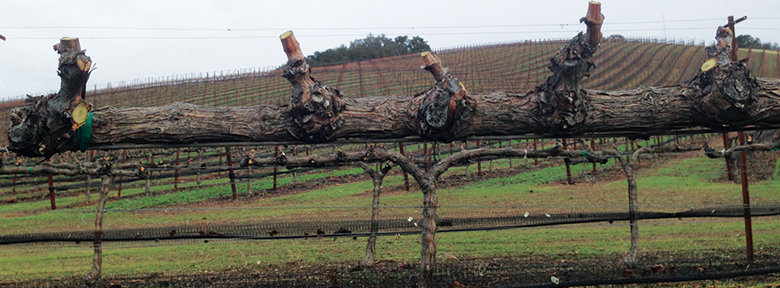 One- and two-bud spurs are evenly distributed on a vine with vertical shoot positioning (VSP) trellising.
One- and two-bud spurs are evenly distributed on a vine with vertical shoot positioning (VSP) trellising.Bud break and young shoot growth occurs rapidly across winegrowing regions, and warm temperatures hasten the workload for vineyard-management crews. Canopy management, shoot thinning and selective shoot removal are on the minds of most growers at this time. It is easy to get lost in the details of the next task when shoots are growing rapidly, but let’s not miss the opportunity to take a critical look back at the pruning work that has occupied the past few months.
Pruning is arguably the most important vineyard task. If done properly, it will greatly improve vineyard management during the season. A critical assessment of your pruning job is best accomplished between bud break and bloom. Hence, the proof of success of your pruning strategy is by now (or soon will be) evident.
Bud count vs. shoot number
READ MORE »
Growing & Winemaking
May 2016A Conversation with Ryan Harms
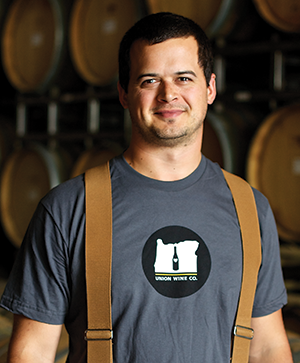
When Ryan Harms started classes at Binghamton University in upstate New York, he planned to become a doctor. But during his sophomore year, “Organic chemistry kind of did its damage.”
READ MORE »
Growing & Winemaking
April 2016Suppliers, Industry Seek Clarity on Yeast Sales Tax
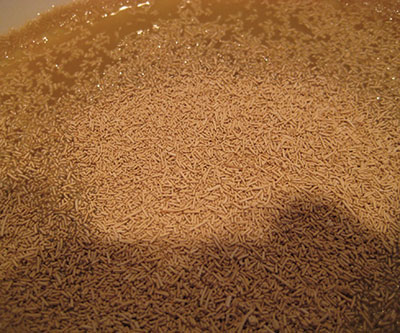 The total global yeast market is estimated to grow to $4.3 billion by 2020. Winemaking is the third-largest use of yeast behind baked goods and brewing.
The total global yeast market is estimated to grow to $4.3 billion by 2020. Winemaking is the third-largest use of yeast behind baked goods and brewing.Given oxygen, stable temperatures and a supply of sugar, yeast will happily get to work powering a fermentation.
And perhaps at the microbial level, the yeast do not even perceive a difference between fermenting beer and wine. In California’s capital city of Sacramento, however, the state department that applies sales tax did see a difference between yeast used for brewing and yeast used for winemaking: Wine yeast was subject to sales tax, while brewing yeast was not.
According to the California State Board of Equalization (BOE) sales tax annotation 440.0780, selling yeast to wineries was taxable because “yeast is used in the manufacture of wine in order to bring about the fermentation process and is not used for the purpose of physically incorporating it into the wine.”
Annotation 245.1101 stipulates, “Tax does not apply to the sale of viable yeast, which is sold as a food for human consumption in the production of bread and malted alcoholic beverages such as beer, mead and ale.”
The difference, according to the state BOE, is that “yeast for wine is not incorporated, and thus, not consumed by humans.”
Earlier this year, however, an attorney with the BOE made the unexpected decision that the viable yeast sold for winemaking is in fact a food product and should not be subject to a sales tax. Suppliers and industry representatives had been pushing for a change for years but made little progress with the state.
Winemaking to get a little cheaper
READ MORE »
Growing & Winemaking
April 2016Terroir and Other Myths of Winegrowing
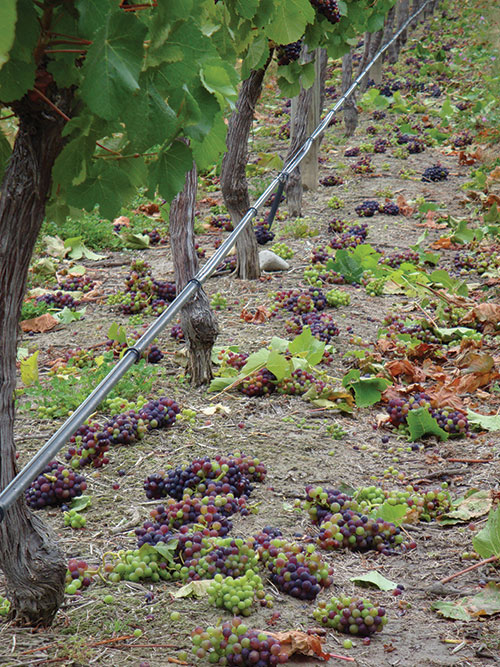
Editor’s note: Terroir and Other Myths of Winegrowing explores popular winegrowing concepts including yield, berry size, vine balance, a critical ripening period, and terroir. The book is currently available from the University of California Press (ucpress.edu). The following excerpt from Terroir and Other Myths of Winegrowing explores popular concepts related to wine quality and crop yield.
READ MORE »
Growing & Winemaking
April 2016Packaging Planning Is Critical for Bottling Day
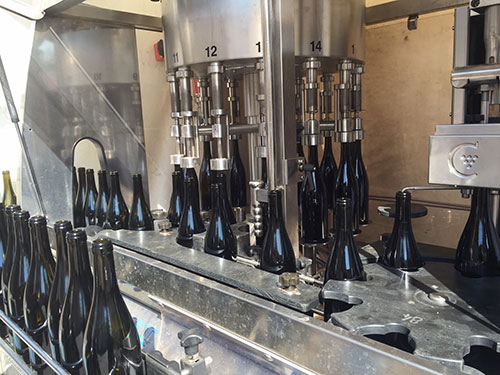 Start planning for bottling day six months in advance if you have used your suppliers before and 12 months ahead for new products or items that are going to require design work.
Start planning for bottling day six months in advance if you have used your suppliers before and 12 months ahead for new products or items that are going to require design work.Here’s an example of two ways to solve the same problem.
1. You need open heart surgery. You have a surgeon (probably a highly recommended referral from your primary care doctor). He or she works with a hospital to book a time and date; all the doctors, nurses, tools, supplies and equipment are in place on the day of your surgery. You defer to their planning and expertise. You eat nothing the night before. The system works. You live a long time and get to meet your grandchildren.
2. You need open heart surgery. You call a few hospitals to see who has open surgery rooms. Your No. 1 priority is to get a good price, because, “Hospitals are a commodity, and it’s my money!” Then you hire a doctor, bring in some nurses from a temp agency who also gave you a heckuva deal, buy scalpels, bandages and oxygen tanks from a range of vendors (you get to go on one vendor’s annual fishing trip if you buy from them), and tell them all to ship to the hospital the day before your surgery date. You don’t ask the hospital which surgery supplies they recommend. A scalpel is a scalpel. Also, you hate the idea of surgery almost as much as you hate bottling wine, so you don’t waste time keeping tabs on your suppliers to see if they will make their delivery dates. Surgery day arrives and…
Wine quality matters. You must have an executed package that’s worthy of that wine and its price, but that can’t happen until it is safely bottled with a closure, capsule, TTB-approved label and shipping case. And that’s the bare minimum. Do you remember the scene from the film “Office Space” when the manager of Chotchkie’s restaurant scolded Jennifer Aniston for wearing only 15 pieces of flair? “What does that say about you, just doing the minimum?”
My premise is that designers, materials vendors and bottling services vendors must collaborate on behalf of winery and brand owners. When that doesn’t happen, it’s usually not because they don’t want to do it, but because the winery doesn’t see planning as a critical and collaborative process with potentially divergent criteria for each vendor (e.g., cost, quality, speed).
Winery owners should note that when bottling day problems arise, winemakers will likely blame vendors for their “crap (insert packaging supply here)”, yet a more objective assessment might be that the winemaker planned poorly.
Learning from wineries
READ MORE »
Growing & Winemaking
March 2016The Role of Bacteria in Stuck Fermentations
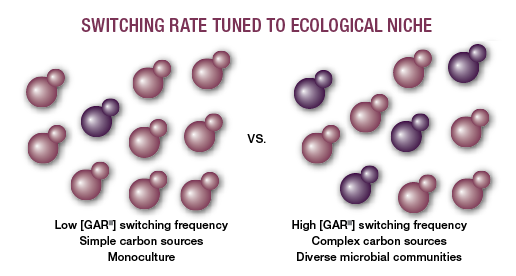
Hundreds of articles about stuck fermentations cover how to avoid them as well as restart them. It is an art that relies on experience and intuition about what went wrong with a particular fermentation. The traditional methods that help to avoid stuck fermentations include assessment of spoilage organism potential, nutritional status of the initial must and viability of the yeast used relative to the style of wine desired.
Many laboratories servicing the wine industry offer assessment panels to test a winery’s grapes, but in most cases winemakers don’t use that service until it is too late. The sooner the winemaker understands there is a problem, the easier it will be to begin a triage of the situation and the better the resulting wine will be.
Even when a winemaker thinks all bases are covered, occasionally fermentation for a certain wine won’t perform the same way it did in previous seasons. As a wine consultant and winemaker, this has always been a bothersome situation to resolve: Why would this wine, this season, not complete fermentation? This was the case with wines from a recent client of mine. The winery had a series of wines with fermentations that had started normally. Then, sometime after the lag phase had passed and the yeast was on the concluding side of the fermentation curve, the rate slowed to a crawl and apparently stopped at about 2° Brix. After trying all the traditional paths to restart the fermentation, they asked me to figure out what might be causing this situation.
When I reviewed the wines organoleptically, I found no off odors. Analysis showed volatile acidity was below any threshold and, therefore, not a problem. VA is one of the more frequent causes of stuck fermentations at this level, and remedial efforts that would exacerbate that situation should be avoided.
However, one of the techniques the client had tried was to introduce lysozyme, which is frequently added to reduce the bacterial load in a fermentation. Lysozyme is most effective against gram-positive bacteria, which meant that after the lysozyme addition, the wine still could have had Acetobacter or other acetic acid-producing bacteria present.
Macro oxygenation is a technique frequently used to help fermentations. Yeast are facultative organisms, meaning they can survive both in aerobic and anaerobic environments. In a normal fermentation during lag phase, yeast grows rapidly and lives off the dissolved oxygen that is in the must. Eventually the organism population exceeds the capacity of the must to bring more oxygen in from pumping over, and so the yeast switch from aerobic metabolism to anaerobic metabolism. That is when augmentation of yeast growth is helped by injection of up to 60 mg/L per day of oxygen into a must, which can encourage the yeast to continue to grow at maximal rates. This technique is not without some peril, as Acetobacter are not facultative organisms. Withdrawing oxygen slows and then stops growth of the acetic acid bacteria during fermentation.
If you know that there are Acetobacter organisms present, you need to monitor any additions of oxygen to maintain the health of the wine. It was with much caution that I broached the possibility of adding oxygen to these fermentations. At this time I remembered a news brief published by Linda Bisson from the University of California, Davis, about a new concept of yeast metabolic regulation by bacteria that involved prions.
Use of the environment
READ MORE »
Growing & Winemaking
March 2016A Conversation with Markus Bokisch
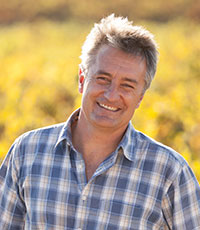 Markus Bokisch
Markus BokischMarkus Bokisch, owner of the vineyard-management company Bokisch Ranches in Lodi, Calif., isn’t the area’s largest grower. He is, however, considered one of its most influential.
READ MORE »
Growing & Winemaking
January 2016Top Seven Mistakes New Grapegrowers Make
I have worked with many vineyard startups during the past decade and evaluated prospective vineyard sites for countless soon-to-be grapegrowers east of the Rocky Mountains. New growers often start growing grapes while working other jobs or after a previous career—frequently one not related to agriculture. The transition to grapegrower has a steep learning curve, and that is typically where the university or private vineyard advisor has the biggest impact on improving the success rate for vineyards.
READ MORE »
Growing & Winemaking
January 2016Attracting Birds of Prey
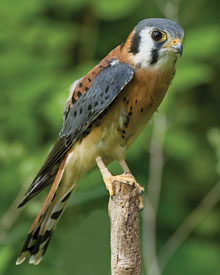 Kestrels hunt large insects as well as small mammals and other birds.
Kestrels hunt large insects as well as small mammals and other birds.Grapegrowers can attract certain types of birds to their properties to help deter other pest species. While native birds of prey won’t necessarily be the free and quick solution to prevent bird damage in vineyards, attracting the predators could be an interesting addition to the strategy. Plus, referring to your local family of barn owls as “vineyard beneficials” seems kind of cool.
Advice from the U.S. Natural Resources Conservation Service (NRCS) suggests the introduction of barn owl boxes, kestrel boxes and raptor perches could be part of a “multifaceted solution to pest control” that could include other conventional methods such as netting and audible deterrents.
The NRCS said barn owls and kestrels are relatively easy to attract to farmland by installing nest boxes. Nesting pairs of predatory birds focus their hunting near the nests and will capture increased amounts of prey for their growing chicks. These species are easy to attract with nest boxes because natural nesting cavities can be difficult to find.
While owls primarily prey on nocturnal rodents, they are known to kill and stockpile more prey than needed. Kestrels, formerly known as sparrow hawks, will hunt large insects such as grasshoppers, crickets, beetles and moths, as well as small mammals and birds.
Attracting birds of prey may also help with avian pests, such as starlings, by changing their behavior. Additionally, the presence of predators may make pests more cautious and less likely to enter the area to feed.
Attending to small details will make a nest box more suitable to attract and fledge birds. Important factors include the number and location of boxes, timing of box setup, predation and competition, management of the area around the box, and box design.
Number of boxes and location
READ MORE »
Growing & Winemaking
January 2016Warming to New Tartrate Stabilization Methods
Tartrate stabilization, often called cold stabilization, is a wine treatment for the cosmetic benefit of avoiding tartrate crystal formation. Intellectually you know you don’t really need to do it, but you do it anyway. So the priority is to get it done while minimizing both the risk of degrading wine quality and cost.
Until recently, winemakers had few choices. Typically they would set their glycol chiller to 20° F or so, then cool a tank to 26°-28° F for several days and let it slowly warm back up on its own. To speed up the process, winemakers might seed tanks with potassium bitartrate (KHT), and/or use heat exchangers to warm up chilled wine.
READ MORE »
Growing & Winemaking
January 2016A CONVERSATION WITH Merry Edwards
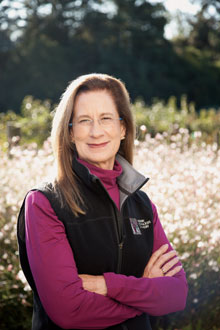 Merry Edwards, Pinot Noir specialist, weighs in on the 2015 harvest.
Merry Edwards, Pinot Noir specialist, weighs in on the 2015 harvest.Pinot Noir specialist Merry Edwards, now in her fifth decade as a winemaker, started cooking with wine as a teenager, inspired by some cookbooks from the California Wine Advisory Board. Her interest in wine grew during her college years at the University of California, Berkeley, when Edwards started experimenting with fermentation of both fruit wines and beer. But her studies focused on physiology, and when she graduated in 1970, she planned to write about nutrition.
READ MORE »
Growing & Winemaking
December 2015What It Costs to Be Certified Organic or Biodynamic
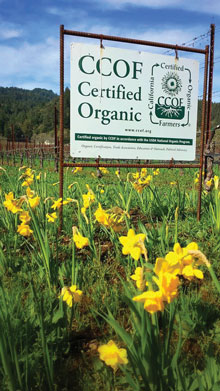 A sign identifies Ehlers Estate vineyard as organic.
A sign identifies Ehlers Estate vineyard as organic.Winery and vineyard owners often cite the cost of organic certification as the reason for not certifying their vines or wines. But are the costs of certification really that high? Putting aside the debate about whether or not organic farming costs are higher, many organic producers and certifiers say wine sellers and members of the wine industry in general don’t understand how inexpensive certification fees are.
Certification fees were not initially high, but the 2014 Farm Bill reduced them even more, giving small farmers a lift. The federal legislation lowered costs for the nation’s 15,000 organic farmers (including 200-plus organic wine grape growers and vintners) by providing subsidies of up to $750 each for organic vineyards and organic wineries.
Winemaker and winery owner Julie Johnson, who farms 12 acres of certified-organic vineyards at her Tres Sabores Winery in Napa’s Rutherford appellation, was glad to see the subsidies offered to organic farmers this year.
“Effectively you get back a rebate up to 75% of organic certification fees, up to $750,” she said. “That reduced my annual bill—usually $1,200—quite a bit.”
For example, with the subsidies, a Napa, Calif., farmer growing 10 acres of Cabernet Sauvignon yielding 4 tons of wine grapes valued at $6,000 per ton (for a per-acre yield of $24,000) would pay a California Certified Organic Farmers (CCOF) certification fee on $240,000 worth of grapes, which works out to $40 per acre.
For a Monterey County, Calif., grower with 100 acres yielding 4 tons of wine grapes valued at $1,300 per ton (for a per-acre yield of $5,200), the CCOF certification fee would amount to $11.50 per acre per year.
Certification required
READ MORE »
Growing & Winemaking
November 2015A CONVERSATION WITH Juan Jose Verdina
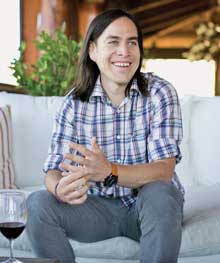 Juan Jose Verdina is responsible for wines produced under the Jamieson Ranch, Reata, Light Horse and Whiplash labels.
Juan Jose Verdina is responsible for wines produced under the Jamieson Ranch, Reata, Light Horse and Whiplash labels.A native of Chile, winemaker Juan Jose Verdina grew up around farming. His grandparents grew vegetables and other crops, fostering Verdina’s love for agriculture. He studied agricultural engineering in Santiago, Chile’s capital city, and got an internship at the region’s largest wine producer, Concha y Toro, piquing his interest in grapes.
Verdina was also interested in traveling and thought he could travel the world by working two harvests a year. In 2002 he took an internship at Hahn Estates in Monterey County, Calif., then returned to Chile to finish his studies. When Hahn’s then-president, Bill Leigon, offered Verdina a long-term job, he knew it would mean putting those travel plans on hold, but he accepted the job and eventually was promoted to assistant winemaker, working with the Rex Goliath brand. (Rex Goliath was sold to Constellation Brands in 2005.) Verdina returned to Chile in 2008 as winemaker for Copa Del Rey, a joint venture between Hahn and a Panamanian family in Chile’s Rapel Valley. Then it was back to Hahn in 2010 as winemaker for the Cycles Gladiator brand.
Leigon, meanwhile, became president of Jamieson Ranch Vineyards in California’s Napa Valley in 2013, and he hired Verdina as winemaker the following year. This September, Leigon bought the Jamieson Ranch brand and inventory. Verdina is responsible for wines produced under the Jamieson Ranch, Reata, Light Horse and Whiplash labels.
Wines & Vines: You spoke at the Wines & Vines Packaging Conference about your work with Free Flow Wines to package some of your wines in kegs. What is your procedure? Are your parameters for things like filtration and sulfur dioxide different for kegged wines than for bottled wines?
Juan Jose Verdina: Our procedure for kegging does not vary too much from bottled wines. We create all parameters the same, whether we are bottling or kegging the wines (CO2, DO, FSO2, etc.). We adjust all wines in the Jamieson Ranch Vineyards cellar before we ship to the kegging facility. Once at the kegging facility, they filter the wines through a traditional 0.45-micron sterile filter and make final adjustments according to our protocol.
Free Flow is in the Napa Valley Corporate Park, just a few minutes from the winery. Since kegging volumes are generally much smaller than bottling volumes, we normally ship the wine to Free Flow in stainless steel porta-tanks on a flatbed truck. We do this rather than shipping in a tanker truck in order to minimize oxygen headspace in the vessel. We always gas the headspace heavily with nitrogen or argon for the best protection against oxygen and to keep the wine as fresh as possible.
There are pros and cons to kegging a wine vs. bottling it. One of the pros is certainly the cost. To put a wine in keg costs roughly $5.23 a gallon, whereas bottling the same wine can cost up to $8.15 a gallon. The cost differential is a result of the packaging associated with bottling—glass, corks, capsules, labels—all of which are not part of kegging. On the flip side, a con of kegging would be that a customer cannot purchase a bottle to take home with them and share with family and friends who may purchase another JRV wine in the future. One other big advantage of having wine in keg is to accommodate consumers who may not be able to pay a premium price for high-quality wines in a restaurant, so they have the option to purchase a single glass and enjoy the same wine. Currently our wines being offered in keg are Double Lariat Napa Cabernet, Reata Three County Pinot Noir, Reata Carneros Chardonnay and Silver Spur Napa Sauvignon Blanc.
W&V: After the wines are kegged, do you find any differences between those wines and bottled wines, either in the chemistry or the sensory qualities?
Verdina: We have found that there are only minor differences between kegged wines and wines from a bottle, primarily in aroma. We believe wines in keg are more expressive up front on the nose, and this expression may change depending on the temperature the kegs are poured at. Here in our tasting room, we have found that reds on tap that are poured below 60° F tend to move further away from the bottled wine’s profile, so we recommend pouring reds at or above 60° to ensure that the expression and sensory characteristics more closely match that of the same wine in a bottle. If you chilled a bottled wine down to the same temperature as the keg, it would have a more consistent profile with the keg. However, each bottle varies in terms of CO2 levels and micro-oxygenation, so there is more consistency overall with kegs.
READ MORE »Growing & Winemaking
November 2015Extracting Phenolics in Red Wine
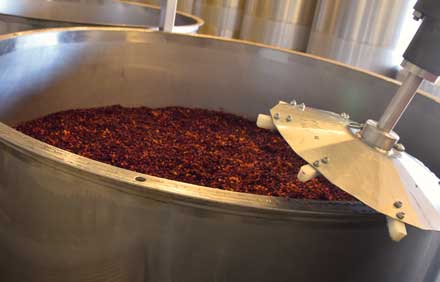 Periodic punchdowns improve color by increasing contact between juice and grape skins.
Periodic punchdowns improve color by increasing contact between juice and grape skins.Article from Il Corriere Vinicolo
Editor’s note: This article is published as part of Wines & Vines cooperative editorial effort with Il Corriere Vinicolo, the leading Italian wine industry publication. Il Corriere Vinicolo is edited by Unione Italiana Vini, the largest Italian wine trade association. On a regular basis, our two publications will share key articles in order to give readers a broader view of important wine industry topics in Italy and North America.
The sensory qualities of wine are the result of a complex balance between wine components. The polyphenolic component, in particular, distinguishes and influences the quality of red wines. This group of substances determines color, sensory sensations of bitterness and astringency, and forms the structure and body of the wine, with an impact on its longevity.
The polyphenolic substances of wines are basically derived from the grapes, where they are contained in the solid parts of the bunch (skins, seeds and stems), as shown in the berry diagram on page 104. For many winemakers it is common practice to only exploit the solid parts of the berries, removing the stems that could add unpleasant bitter and herbaceous flavors.
The term polyphenols indicates various classes of compounds that differ for their chemical structure, properties and concentration. The main classes of polyphenolic compounds of red wines and the spectrophotometric indices used to assess them are summarized in the table at the bottom of page 104.
The passage of the components from the solid parts (particularly polyphenols) to the liquid phase is not as simple or immediate as that of the solutes in the grape’s pulp, necessitating an extraction process between different phases as well as contact between the liquid phase and the solid parts.
This process is generally referred to as “maceration.”
To complicate everything, there is also the varied location and the chemical and physical state of polyphenolic substances present in skins or seeds, with substantial differences for the same class of substances. The anthocyanins are located in the vacuoles of cells in the hypodermis of skins (rarely in the pulp). The proanthocyanidic tannins in skins, contained in the same tissues, represent a highly complex situation, as can be seen in the black and white diagram at the top of page 104. The tannins in seeds are contained in the various layers of cells that make up the external coat. In the seeds, monomer flavanols and oligomer forms are predominant, whereas in the skins we mainly find the polymerized forms. The flavanols in seeds have higher values of the FRV/PC ratio than those in skins.
The presence and quality of phenolic substances in red wines inevitably requires suitable work in the vineyard and monitoring in order for the raw material to reach optimal phenolic ripeness. During the vinification process, maceration is the fundamental stage for the properties of the wine. It lays the foundations for the quantity and quality of the complex development processes that characterize the aging of both great red wines and those meant to be consumed young.
Factors of extraction
READ MORE »Growing & Winemaking
October 2015Winemaker Interview: Ross Cobb
While winemaker Ross Cobb was studying biology at the University of California, Santa Cruz, in the late 1980s, his father, David, was establishing Coastlands Vineyard in the Freestone/Occidental area of California’s Sonoma Coast. As he helped his dad on weekends and during the summer, he fell in love with viticulture and decided to switch to the environmental studies department, where he studied agroecology and sustainable agriculture.READ MORE »Growing & Winemaking
September 2015A New Disease In Italian Vineyards
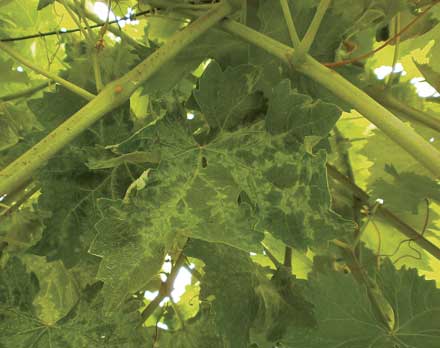 The Glera cultivar displays nerve discoloration on its leaves until the end of the season.
The Glera cultivar displays nerve discoloration on its leaves until the end of the season.First article from Il Corriere Vinicolo
Editor’s note: This article is published as part of Wines & Vines cooperative editorial effort with Il Corriere Vinicolo, the leading Italian wine industry publication. Il Corriere Vinicolo is edited by Unione Italiana Vini, the largest Italian wine trade association. On a regular basis, our two publications will share key articles in order to give readers a broader view of important wine industry topics in Italy and North America.
Grapevine leaf mottling and deformation are the hallmarks of a new vine disease spreading across grapegrowing regions in northeast Italy and Slovenia. The first warning signs came in 2003-04, when symptoms were observed in the vineyards of Piana Rotaliana and Collio. During the next few years, the disease gradually spread to every grapegrowing area in Trentino Alto Adige and Friuli Venezia Giulia—the two regions where it first developed.
The disease then spread to neighboring regions such as Veneto, Emilia Romagna and Lombardy. In Veneto, where it was first identified in the DOCG Prosecco area in 2013, it has become a constant presence, having been detected in each of the best grapegrowing provinces. In Emilia Romagna, there was a high incidence of infected plants in 2013, whereas in Lombardy the disease wasn’t detected until 2014. For the time being, the disease has only a sporadic presence in Emilia Romagna and Lombardy, which each have some hotbeds scattered throughout the region.
The disease was detected for the first time in Pinot Gris, which is where the Italian name for the disease comes from (malattia del Pinot Grigio or “Pinot Grigio disease”), though it was later identified in other varieties. The cultivars most affected so far are Pinot Gris, Pinot Blanc, Pinot Noir, Gewürztraminer, Tocai Friulano and Glera (a grape used for Prosecco production), all typical varieties in the regions where the disease is most widespread. No data is currently available on the susceptibility of other varieties common to Italy and other European regions, although Merlot and Cabernet seem to show few or no symptoms at all.
Fortunately, the incidence of Pinot Grigio disease in the affected areas has remained generally low. In the vineyards observed in Trentino Alto Adige, the average incidence in susceptible varieties was said to be around 0.5% during the past two or three years. In Friuli Venezia Giulia and Veneto, the incidence might be lower. Symptomatic plants are present sporadically and in an isolated manner in most vineyards. However, when the incidence of disease is higher, there is generally a distribution in groups, localized both in the center and at vineyard edges. There are, however, some vineyards where symptomatic plants appear randomly distributed throughout the whole vineyard.
Symptoms and damage to production
READ MORE »Growing & Winemaking
August 2015A CONVERSATION WITH Doug Fletcher
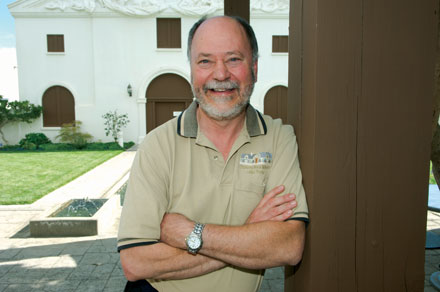 Doug Fletcher, named vice president of winemaking for the Terlato Wine Group in 2006, discusses closures.
Doug Fletcher, named vice president of winemaking for the Terlato Wine Group in 2006, discusses closures.Doug Fletcher began his winemaking career in the mid-1970s at Martin Ray in California’s Santa Cruz Mountains, but for the past three decades the Stags Leap District of the Napa Valley has been his winemaking home. After helping start Steltzner Vineyards in Napa, Calif., he was hired in 1987 as winemaker at Chimney Rock Winery.
READ MORE »Growing & Winemaking
August 2015Successful Small Wineries Know Their Core Competencies
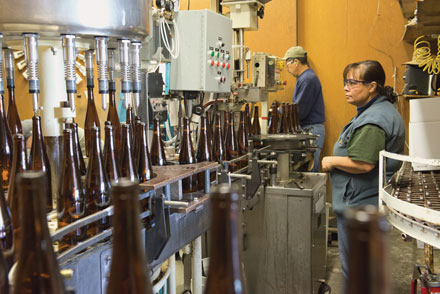 Bottling in-house provides Navarro Vineyards with flexible scheduling.
Bottling in-house provides Navarro Vineyards with flexible scheduling.Let’s start with two definitions. Core competencies are the unique abilities a company develops that cannot be easily imitated. Non-core competencies are headaches you should probably outsource.
Owning or running a winery is supposedly the No. 1 “second career” choice of middle-aged executives, especially those who wear uncomfortable clothes to work in the steel and glass cages commonly known as traditional offices. Like well-dressed prisoners on furlough, office workers visit wineries on the weekends and imagine how magical it would be to top off barrels all day. Those of us in the business know the real story is a little different.
READ MORE »Growing & Winemaking
June 2015A CONVERSATION WITH Michael Pierce
 Michael Pierce is the director of enology at Arizona's Yavapai College.
Michael Pierce is the director of enology at Arizona's Yavapai College.Winemaker Michael Pierce grew up far from vineyards in Phoenix, Ariz. He studied electronic media and visual communication at Northern Arizona University, and after graduating in 2004 he went to work doing print and web design.
READ MORE »Growing & Winemaking
April 2015Matchbook Wine Co. Expands Hospitality and Production
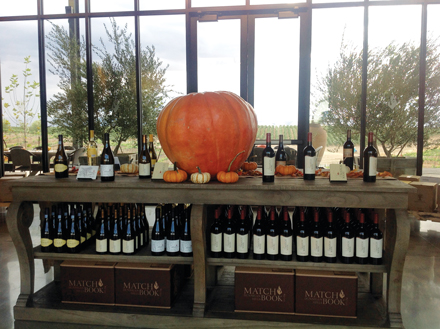 A new tasting room opened in October 2014. Floor-to-ceiling windows look out over newly planted Tempranillo.
A new tasting room opened in October 2014. Floor-to-ceiling windows look out over newly planted Tempranillo.Located in the Dunnigan Hills of Yolo County, Calif., Crew Wine Co. continues to expand wine production capacity and estate vineyards to support its growing Matchbook and Sawbuck estate wines, and to increase capacity for its Mossback, Chasing Venus brands and Arsonist brands. During its most recent growth phase, the winery added tank and barrel capacity, a new press and its first tasting room. Once bottled, wine production for the 2014 vintage will exceed 100,000 cases. Crew co-owner Lane Giguiere said with future planting and expansion, production is on track to ultimately reach 250,000 cases per year.
“We introduced a new wine to our line up—our Arsonist Dunnigan Hills Chardonnay,” Giguiere told Wines & Vines. “We will release the Arsonist Red Blend (Petit Verdot, Cabernet Sauvignon and Merlot) in April.”
Partner and winemaker Dan Cederquist said, “We’re one of the fastest growing young wine brands in the country, and we keep adding facility capacity each year. Our tasting room is long overdue.”
Cederquist told Wines & Vines that Crew’s 2015 crush is expected to total 2,500 tons of grapes (up from 1,800 tons in 2014) as new vineyards come online. Five new stainless steel tanks, fabricated and installed by Westec of Healdsburg, Calif., added 100,000 gallons of processing capacity leading up to the 2014 crush, and a new Diemme AR 150 press was installed. A 5,000-square-foot barrel building built in 2013 had reached capacity by September, and plans call for construction of a 20,000-square-foot barrel storage facility with lab and winery staff offices in 2015.
Giguieres build on past experience
READ MORE »Growing & Winemaking
February 2015A Conversation with James Kennedy
James Kennedy specializes in tannin chemistry.Dr. James Kennedy, chair of the Department of Viticulture and Enology at California State University, Fresno, was raised near another famed wine school, the University of California, Davis. Growing up near the university’s farm, Kennedy says he was “fascinated with the grape and wine industry at a young age.”
READ MORE »Growing & Winemaking
January 2015Choosing Vineyard Management Software
Photo Courtesy AgcodeEditor’s Note: This is the second installment of a series that will provide an overview of the software available to the wine industry. This report examines vineyard management software and will be followed by winery and finally the marketing and sales information management software.
Anyone with even cursory knowledge of the wine industry knows its complexity and some of the arcane regulatory hoops through which we must leap. The software we use for information tracking and compliance must accommodate variables from regulatory bodies, regional trade groups and sustainability organizations.
We have grouped the software providers into segments organized by the software’s primary focus. The companies in each segment provide information relative to that segment for your vineyard.
INSTRUMENTATION AND EQUIPMENT
READ MORE »Growing & Winemaking
January 2015Focus on Oak in Winemaking
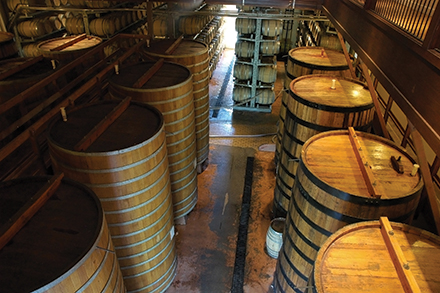 The Wines & Vines Oak Conference will be held Feb. 11.
The Wines & Vines Oak Conference will be held Feb. 11.From the technical to the stylistic, the use of oak in winemaking will be the focus of the upcoming Wines & Vines Oak Conference to be held Feb. 11 in Napa, Calif.
Registration is now open for the conference, which will feature several expert panel discussions and technical tastings as well as a seminar about seismic safety incorporating lessons learned from the Aug. 24 earthquake in Napa Valley.
The conference includes breakfast, lunch and a trade show with more than 30 exhibitors ranging from coopers to oak barrel alternative producers and other wine industry suppliers. The conference will take place at 500 W. First St. in the building that originally housed the Copia center. Wines & Vines used the same building to host its inaugural wine packaging conference, which will return Aug. 19, 2015.
David Ramey to speak
READ MORE »Growing & Winemaking
January 2015Role of Yeast in Winemaking
Attendees sampled wines inoculated with both wild and cultivated yeast strains.In an effort to find what microbes might be affecting commercial wineries, professor David Mills from the University of California, Davis, swabbed locations all over the UC Davis research winery before and after harvest. His findings included a large number of microorganisms—some unfamiliar to most winemakers, and others that are identified with toxic microbes (though not the strains found).
Mills revealed his discovery during a session about “wild” yeast strains at Rootstock, a Napa Valley Grapegrowers conference and exhibition held in Napa, Calif. (See “Napa Grapegrowers Consolidate Events” on page 162.)
The session also examined the role of what could be called feral yeasts (cultured yeasts that have gone wild).Researchers at the UC Davis research winery found Saccharomyces yeast around the garage-sized door used to bring in grapes—even before there were grapes in the winery.
Mills also found Brettanomyces in a stainless tank. It turns out the tank had been used for work involving that yeast a year before, and it had been thoroughly cleaned after use.
The researchers are trying to determine how the microbes got into and moved around the winery. Some possibilities include humans, equipment and insects, notably the fruit fly Drosophilia. The latter turned out to mostly spread Saccharomyces and other yeasts, not acetic acid and lactic acid bacteria as commonly thought.
Quick and cheap identification
READ MORE »Growing & Winemaking
January 2015Balanced Water Management for Vineyards and Salmon
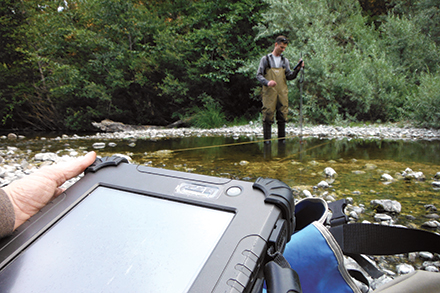 The Nature Conservancy calibrates stream-flow gauges.
The Nature Conservancy calibrates stream-flow gauges.It’s no secret. In California it’s all about water, especially during one of the worst droughts in history. And especially for Nancy Smith, project director for The Nature Conservancy’s Navarro River Watershed Project in the Anderson Valley of Mendocino County, Calif.
“Working in water management in California is like being an archaeologist working in Egypt,” Smith said. “California is where it all began in western water law. Finding solutions here is like finding the Rosetta stone for water management all over the west.”
In the Anderson Valley, a small but booming center of viticulture, it takes a lot of water to support a wine economy. Likewise, it takes watershed-wide planning to balance the needs of this thriving sector with vital species of plants and animals; this includes freshwater science and cutting-edge technology—not to mention a lot of cooperation. The Nature Conservancy has teamed with wine grape growers and other landowners in this region to install stream gauges that will help water managers better balance the needs of both grapes and salmon.
“We have 12 landowners participating in our project so far,” Smith said. “That means 100% of the people we approached agreed to putting a stream gauge on their property. In our work, that kind of cooperation is rare, and it shows how committed these folks are to preserving what makes the Anderson Valley special.” The Conservancy has also been coordinating with the Mendocino Resource Conservation District and Natural Resource Conservation Service to maximize impacts of the project.
In other regions, water conflicts between environmental groups and vineyards recently have led to acrimony and lawsuits, creating a stalemate that threatens both fish populations and the vitality of an important economic sector. But the Anderson Valley is different.
“We’re different because we’re all predisposed to dealing with limited water, so all of us were already doing something to conserve water,” said Michael Fay, Goldeneye winemaker for Duckhorn Wine Co. “We’ve always had to be so aware of how valuable water is, so once we knew The Nature Conservancy had their heart in the right place, everyone in this valley wanted to get involved.”
Plenty of water, but timing is problematic
READ MORE »Growing & Winemaking
January 2015Growing More with Less Water
Rodney Strong's vineyards in the Russian River and Alexander valleys are equipped with Adcon weather stations.Ryan Decker, grower relations manager for Rodney Strong Wine Estates, admits that he cannot control the climate, but he can deliver prescribed amounts of irrigation water to a constellation of vineyards located in one of the most diverse grapegrowing regions in California. He tends Chardonnay growing from dark clay near the San Pablo Bay, Petite Sirah, Touriga Nacional and Zinfandel planted in alluvial soil not far from the Russian River and Cabernet Sauvignon growing from a rocky, inland hillside close to the Sonoma-Mendocino county line.
Near the confluence of the Alexander Valley, Chalk Hill, Russian River Valley, Sonoma Coast and Sonoma County AVAs, the winery overlooks a river basin that meanders 32 miles, or nearly a third of its length, to the sea. During the growing season, warm air rises from inland valleys drawing fog through the Petaluma Gap and along the Russian River Valley where it gathers near Healdsburg, Calif., before spilling into the Alexander Valley.
South of the winery, fog dampens daytime temperatures and helps drive a seemingly endless cycle of misty mornings, warm days, windy afternoons and cool nights. To the north, fog dissipates from the river basin early in the day giving way to warmer afternoon and nighttime temperatures.
Alexander’s Crown, a rolling hillside vineyard located at the southern end of the Alexander Valley, records an average temperature of nearly 60º F from bud break to harvest. Twelve miles upriver, Brothers Ridge, a steep hillside vineyard, averages more than 67º.
Variations in climate help explain the diversity of this growing region. “The farther you are from the (Petaluma) Gap,” Decker says, “the weaker the marine influence.” At the boundary between maritime and continental air masses, the Alexander Valley, alone, produces 66 varieties of wine grapes.
Following a budget
READ MORE »Growing & Winemaking
January 2015Irrigation Audits Available
To perform a "catch can" test (seen above in a Sonoma County, Calif., vineyard), water is collected from each emitter to ensure flow rates are consistent.Growers in California’s Sonoma and Napa counties can sign up for an evaluation of their drip-irrigation systems to ensure they’re watering as efficiently as possible.
The resource conservation districts in Sonoma and Napa counties are offering irrigation system evaluations through their mobile irrigation labs. After scheduling an evaluation, a district staff member spend about six to eight hours evaluating an irrigation system.
Keith Abeles manages the program in Sonoma County. He said the evaluations typically involve an interview with the property owner to get a sense of the system before conducting a thorough audit using a protocol developed at California Polytechnic State University in San Luis Obispo and the California Department of Water Resources.
Abeles conducts a number of tests of the irrigation system to evaluate if emitters are working as designed and if the entire system is operating with the right pressure to ensure there is not too much or too little water being used. Testing includes a full system flush to look for plugged emitters and to evaluate what may be in the system like sand, clay, insects or algae. This also provides insights into the pump and filter system. The tests also are combined with a site evaluation to determine how topography can impact flow rates. Abeles said an optimal system is one that is providing a uniform rate of flow. “The idea is to get the distribution uniformity as even as possible,” he said.
Abeles has conducted a few of the evaluations in Sonoma County and said the district is offering the service for free—although they may need to start charging in the future. The Napa Conservation Resource District also is offering the evaluation free to the first 10 vineyard owners who sign up and at a cost of $200 per evaluation after that. Frances Knapczyk, who is managing the program for the Napa County Resource Conservation District, said the district could waive the fee if the vineyard manager provides an employee to assist with the evaluation.
Pilot program in Russian River Valley
READ MORE »Growing & Winemaking
December 2014The Birth of Precision Bottling
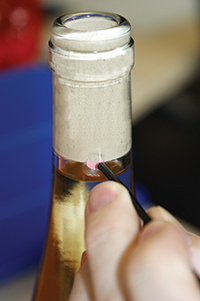 Winemakers use NomaSense technology to measure oxygen pickup inside tanks, hoses, pumps and bottles.
Winemakers use NomaSense technology to measure oxygen pickup inside tanks, hoses, pumps and bottles.Of all beverages, wine is the most varied. While one can classify beers into a handful of types, and spirits into 10 basic bar pours and a hundred cordials, wines cannot be lumped into any less than 1,000 significant varietal types and European appellations, plus any number of proprietary blends. There are more than 250,000 wine brands for sale in the U.S. market alone, and easily 1 million for sale somewhere in Europe.
Yet within this variation lies one prime directive: that a given specific label shall be consistent within itself. Wines do not exist to slack thirst, but to spark the intellect. Specific wines of any stripe are presupposed to be as consistent as movies, with every copy identical. Without this cardinal rule, the entire edifice of wine sales—Wine Spectator scores, Parker reviews, tech sheets, gold medals, flash sales, blogs, point-of-sale advertisements—collapses.
Sophisticated collectors have come to expect and tolerate the bottle-to-bottle variation that accompanies decades of aging, but the workaday wine world is founded on the assumption of product consistency. Like the public faith that sustains the dollar, the economy that pays your salary is firmly rooted in the unshakable belief that for any wine we choose to evaluate, its replicate bottles will behave likewise.
There is just one problem. It isn’t true.
I am not talking about cork taint. That unhappy phenomenon, which first bloomed in the public consciousness in the late 1980s, is easily identified by an expert and exists in no more than one bottle per case under cork. Wineries took action, and this incidence has been further reduced by the growing prevalence of alternative closures. The media, for once, has embraced these new technologies and cooperated in educating consumers. This threat to the industry has been, in my estimation, artfully avoided.
That moldy compound TCA is no longer Public Enemy No. 1. A five-year average of the incidence of technical flaws leading to rejection at the London International Wine Challenge reveals that cork taints were found in 1.8% of wines submitted, comprising 27% of expulsions, with oxidation (27%) and reduction (26%) together comprising more than half of flawed wines, dual artifacts of winemakers’ inability to manage oxygen. As we peel the quality onion, total package oxygen (TPO) management is now in the spotlight.
A new tool
READ MORE »Growing & Winemaking
November 2014Winemaker Interview: Chris Dowsett
Winemaker Chris Dowsett chooses vineyard sites that ripen at lower Brix to keep alcohol levels down without adding water. He also believes warmer fermentations help keep alcohol low.Chris Dowsett made his first wine in 1983, when he was in the 10th grade. It was 10 gallons of Gewurztraminer from his family’s small vineyard in Oregon’s Willamette Valley. The family had purchased the near-abandoned vineyard in the early 1980s, and Dowsett helped his father revitalize and expand it.
READ MORE »Growing & Winemaking
September 2014Resistant Weeds Threaten Vineyards
Working with wheat farmers on Canada’s prairies, agronomist Ken Sapsford of the University of Saskatchewan is no stranger to herbicide resistance in grains.
The use of broad-spectrum herbicides such as glyphosate—best known as Monsanto’s Roundup, though it exists in 22 other formulations—is so widespread that Monsanto has developed Roundup Ready hybrids of some crops to facilitate its use.
But weeds have followed suit, with 28 species worldwide exhibiting resistance to the chemical. Roundup is simply no longer able to corral them.
READ MORE »Growing & Winemaking
August 2014Winemaker Interview: Cameron Hughes
Cameron Hughes started buying ready-to-bottle bulk wines nearly 10 years ago. Photo: Ron SellersCameron Hughes’ early jobs in the California wine industry were as a cellar rat at Corbett Canyon and in sales for The Wine Group. But the Modesto, Calif., native wanted to run his own show and came up with a brand called Cinergi: kitchen-sink blends made from bulk wines. The venture ultimately was unsuccessful, in large part because he was buying inventory before he could sell it.
Hughes went back to the drawing board and came up with the Cameron Hughes Lot Series. The idea was to find good buys on the bulk market and present them to a retail partner (Costco) so he knew he had a buyer before he had to lay out any cash. The Lot Series was launched in 2004 with a 2002 Lodi Syrah.
Ten years later, Cameron Hughes Wines is selling about 400,000 cases per year. Lot Series wines are being sourced globally, and retail channels have expanded. At the time of this writing the Lot numbers had reached the mid-400s, and other brands have been added, including the recently introduced CAM Collection.
Wines & Vines: You started out buying bottle-ready bulk wines for the Cameron Hughes Lot Series wines, but your business model has evolved over the years. How has your business changed?
Cameron Hughes: I started out buying ready-to-bottle bulk wines and bottling them for Costco. At the time, I outsourced the winemaking to someone who could assemble the blends and bottle the wines for me.
This worked well for us for a couple of years, but we quickly learned we could manage the evaluation and purchase of the bulk wine and blend it ourselves at dramatically lower cost. We had a steep learning curve and made a few mistakes along the way. For instance, in 2007 a large Russian River Valley producer, having over-contracted grapes, came to us with a grapes-to-wine production contract for 100,000 gallons of RRV Chard. We just trusted them to make us some great wine. Unfortunately, they picked early and made us a partial malo, 3.1 pH Chardonnay that took 15 months to settle into the bottle, it was so acidic. In not having a hand in the production processes we lost the style, direction and overall quality of the wines and ended up with a cash-flow disaster. We learned from our mistakes, put vineyard protocols in place including clusters per shoot and pick decisions, fermentation and oak protocols.
Over the years our model has changed to adjust to changing market conditions. We still buy ready-to-bottle bulk wine, but the majority of our wine is produced with grower and winery partners to our specifications. In the past few years we have purchased grapes, but only for our high-end Napa projects.
One thing that distinguishes Cameron Hughes wine is our willingness to tailor our deals to the needs of the producing vineyard or winery. Literally every deal is different in its structure. Sometimes the winery has vineyards and would rather put the grapes through their facility for the throughput aspect. Oftentimes we supply barrels (we have about 8,000 barrels), but when they have a formula where they are simply adding our production onto theirs, maybe they’ll buy the barrels and build them into the price, and we take the finished bulk wine and bottle it at a separate facility. Sometimes the winery contracts for the fruit, handles the fermentation through to finished wine and sells us bottled wine out the other end.
Overseeing all of this is a team of two winemakers and a viticulturist. In 2012
READ MORE »Growing & Winemaking
July 2014The Water-Wise Winemaker
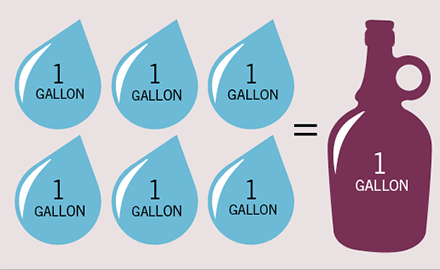 It takes about 6 gallons of water to produce 1 gallon of wine, though figures vary by winery.
It takes about 6 gallons of water to produce 1 gallon of wine, though figures vary by winery.Water is on everybody’s mind these days. We all know it’s a precious resource and one that we must conserve in our homes, in our vineyards and in our businesses. For wineries, where cleaning and sanitation are mission-critical and non-negotiable, it’s tough to rationalize using less. We don’t want to compromise cleanliness (and therefore quality), so coming up with ways to use less water in the winery can seem like a daunting task.
The below tips and tricks are not a universal checklist for every winemaker, as we all have different facilities, different practices and different needs. Some items are easy to implement (like pushing grape skins with a broom instead of a hose), and some are more expensive (like investing in state-of-the-art “clean in place” tanks like the University of California, Davis, has just done). That being said, now is as good a time as any to craft a water-reducing plan at your own winery.
Know your water usage baseline
READ MORE »Growing & Winemaking
June 2014Space and Flow
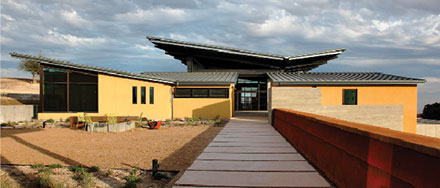 While visitors to the new Law Estate Wines winery in Paso Robles, Calif., enjoy sweeping views, the ridgetop winery is largely screened from view. Photo: Doug Dun/Bar Architects.
While visitors to the new Law Estate Wines winery in Paso Robles, Calif., enjoy sweeping views, the ridgetop winery is largely screened from view. Photo: Doug Dun/Bar Architects.In planning the new Law Estate Wines winery in Paso Robles, Calif., veteran winemaker Scott Hawley took a somewhat novel approach to envisioning the winemaking process.
Instead of focusing on how he could equip the crush pad and cellar, he sought to eliminate steps and machinery to simplify the process. “I sort of wanted to go backward and take out equipment.…Let’s see how easy we can make this,” he said.
Hawley said the finished winery features stunning architecture and design, yet the building facilitates a rather simple and straightforward winemaking process. Several other winemakers with experience in building and planning wineries offered similar thoughts in discussing the keys of good winery design and construction: Simpler is usually better, and extra space can come in real handy.
Cleaning up gravity flow
READ MORE »Growing & Winemaking
May 2014Winemakers Give Clay a Close Look
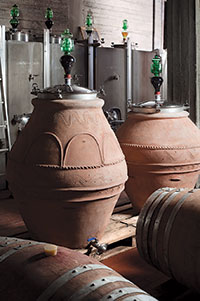 Winery supplier Ipak Wine imports these clay fermentation vessels from Italy.
Winery supplier Ipak Wine imports these clay fermentation vessels from Italy.Winemakers at several different wineries are reporting that they’re impressed with early results from fermenting and storing wine in clay vessels. In another example of how what’s old in winemaking often becomes new again, imported amphoras and clay vessels produced in the United States are finding a place in cellars. Those who have used clay say it imparts unique flavors and aromas to the wine while also giving it a different texture.
Alex MacGregor, winemaker at Saracina Vineyards in Hopland, Calif., said his work developing fermentors with supplier Mission Clay remains “dynamic.”
Varied glazes and firing?
READ MORE »Growing & Winemaking
April 2014Ramping Up Your Winery's Lab
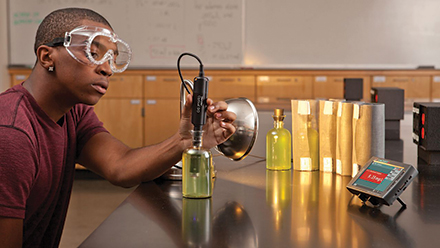 Dissolved oxygen meters give variable numbers. Photo by Vernier Optical
Dissolved oxygen meters give variable numbers. Photo by Vernier OpticalIn the March 2014 issue of Wines & Vines, I described the basic wine laboratory and discussed the minimum laboratory equipment and analytical procedures for soluble solids, total acidity, pH, ethanol, sulfur dioxide and sample preparation. In this article, I will examine more complex testing procedures, the equipment needed to run those tests and different strategies to get your best analysis “bang for the buck.”
Bottled wine integrity
READ MORE »Growing & Winemaking
February 2014Red Blotch Slows Vine Supply
A year ago grape growers and wineries feared that a shortage of grapevines from commercial nurseries could impact their replanting efforts, but nurseries assured them they’d have plenty of vines to plant by now.Red blotch virus has changed all that. The troublesome virus has become a priority issue, and the demand for vines free of the infection has caused a new setback for some nurseries trying to fill growers’ orders. “Red blotch has pushed deliveries back to 2015 and 2016 for many vines,” said Michael Monette of Sunridge Nurseries in Bakersfield, Calif. “We were already juggling vines because of leafroll virus, and now every customer demands vines free of red blotch.”
The National Clean Plant Network (NCPN) at Foundation Plant Services based at the University of California, Davis, has developed strict “Protocol 2010” standards that confirm the absence of many plant pathogens including viruses. To qualify as Protocol 2010 plant material, the vines must have been created using micro-shoot tip culture and tested for an extensive list of pathogens. This process can take several years. Vines that meet the Protocol 2010 standards are planted in the
READ MORE »Growing & Winemaking
January 2014Innovations Unveiled at SIMEI
The global wine industry convened near Milan, Italy, in November for that country’s largest exposition of winemaking and viticulture equipment. SIMEI-Enovitis 2013, held Nov. 12-16, featured more than 600 exhibitors, including 140 visiting from other countries. Organizers estimated more than 50,000 people attended the five-day exhibition that also featured seminars about the global and European wine industries.READ MORE »Growing & Winemaking
January 2014PIGs Save Water in the Winery
Pigging, or the use of sponge balls to move wine and clean transfer lines, offers enhanced sanitation, minimized wine dilution and reduced labor costs. It also can help achieve reductions in winery water use of up to 15%.
READ MORE »Growing & Winemaking
January 2014Watching Over the Vineyards
Karl Wente, vice president of winemaking for Wente Family Estates, has equipped Wente Vineyards with a new generation of electronic tools for tracking growing conditions at the winery’s Livermore, Calif., vineyards. Wente collaborated with AgCode, Enologix, Fruition Sciences, PrecisionAg, Tule Technologies and Wine X Ray to build a network that shaped the information electronic sensors and vineyard and winery teams collected last year into a comprehensive vision for the 2013 vintage.
READ MORE »Growing & Winemaking
December 2013Grapegrower Interview: Steve McIntyre
Although Steve McIntyre trained as a winemaker—he received his master’s degree in enology from California State University, Fresno, in 1982—he is much better known for his skills as a viticulturist.READ MORE »Growing & Winemaking
November 2013Clean Wineries for Quality Wines
Consumers rely on the process of pasteurization to keep milk and fruit juices fresh, but for winemakers, fermentation is a must.READ MORE »Growing & Winemaking
June 2013Winemaker Interview: Celia Welch
Celia Welch’s parents weren’t in the wine business, but she grew up around wine nevertheless. She was raised in Medford, Ore., where her father was a home winemaker who tended a half-acre vineyard, so Welch was able to learn the basics of winemaking and viticulture at an early age. When she decided to make a career of it, she attended the University of California, Davis, graduating in 1982 with a degree in fermentation science.
READ MORE »Growing & Winemaking
April 2013Winemaker Interview: Steve Pessagno
Steve Pessagno, proprietor of Pessagno Winery in California’s Monterey County, grew up around wine. His grandfather, a rancher in the Santa Clara Valley, taught him to make Zinfandel when he was a teen. But he didn’t pursue wine as a career at first.READ MORE »Growing & Winemaking
February 2013Eucalyptus Aromas: A Mystery
(Editor’s note: This article is reprinted with permission from the Wine & Viticulture Journal of Australia and New Zealand, where it appeared in the July/August 2012 issue.)READ MORE »Growing & Winemaking
January 2013Viticultural Geology
This is a tale of three hillside vineyards in Napa, Calif.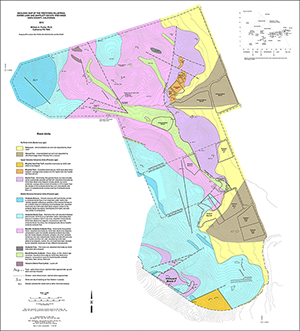 Click here to view the full-size version of this map. Source: Graphics: JBA Works Inc.; CAD: T. ZitkoREAD MORE »
Click here to view the full-size version of this map. Source: Graphics: JBA Works Inc.; CAD: T. ZitkoREAD MORE »Growing & Winemaking
January 2013Ripening Disorders
The ripening process for grape berries involves a coordinated series of changes in color, texture, volatile expression and (most importantly) the accumulation of sugars. Provided the berries follow these highly coordinated events of ripening, a soft and edible fruit with desirable organoleptic qualities will develop as the ultimate end product, one that is suitable for consumption and winemaking.READ MORE »Growing & Winemaking
December 2012Modern Style for Old Soul Wines
In an interview published in 1977, Bernard Fetzer, the founder of Fetzer Vineyards, said he foresaw an inevitable change for the California wine industry.READ MORE »Growing & Winemaking
September 2012Going Underground in Napa
Pulling up to Tres Sabores Winery during the off-season, you might think your GPS has crashed again. Sure, just off Whitehall Lane in Napa there are nicely tended vineyards stretching up and down the hillside, but where’s the winery? If you scour around behind the less-than-imposing main building, you’ll find a stray carboy or two, maybe some cleaning brushes and what looks like winemaking equipment covered (barely) with a tarp—as if a home winemaker hadn’t quite finished cleaning up. You probably wouldn’t guess that this modest, mostly underground facility pumps out 3,000 cases per year of first-class Zinfandel, Cabernet, Petite Sirah, Sauvignon Blanc and a popular proprietary red blend, wines that hold their own against bottles from the edifice wineries just down the road that employ parking monitors for the bus traffic.READ MORE »Growing & Winemaking
September 2012Managing Weeds Without Herbicides
Weed control is almost universally cited as the most difficult management challenge for organic farms, and finding cost-effective alternatives to chemical weed control is seen as somewhat of a holy grail among organic grapegrowers. In the absence of herbicides, expectations of vineyard appearance, management intensity and cost require adjustment. However, a number of potential benefits balance the equation and make these techniques a tangible option for organic and conventional growers alike.READ MORE »Growing & Winemaking
August 2012Rootstock Myths Busted
Almost all winegrapes grown in Washington are grown on the roots they sprouted on, and that’s unusual. In most of the world’s other major wine regions, grapes are grown on grafted rootstock (varietal scions are grafted onto rootstocks resistant to phylloxera and nematodes.) Washington vineyards have not yet been plagued with phylloxera and nematodes—the operative word being yet.READ MORE »Growing & Winemaking
August 2012Kenneth Volk, Take Two
An iconic name in California’s Central Coast, Ken Volk has been producing wines under his eponymous label since 2005. Volk’s name is linked with another seminal brand of the region, Wild Horse, which he founded in 1981 and sold 22 years later to Fortune Brands after growing the business from an inaugural production of 600 cases to 150,000 cases per year.READ MORE »Growing & Winemaking
July 2012Using Micro-Ox To Improve Wine Quality
Safe Harbor, a wine warehouse located in the commercial area around Napa Airport, boasts one of the highest ratios of wine per square foot in the Napa Valley.READ MORE »Growing & Winemaking
July 2012Winemaker Interview: Rick Jones
Rick Jones didn’t set out to be a technical winemaker. His first love was music. But after a three-month tour of Europe as part of Ohio’s Antioch College choral group, Jones gained an interest in wine. He moved to California, started studying chemistry at City College of San Francisco and discovered he was good at science. The combination of wine and science led him to the University of California, Davis, where he earned bachelor’s (1982) and master’s (1984) degrees.READ MORE »Growing & Winemaking
July 2012Building a Pure Custom Crush
Designing a dedicated custom winemaking facility is very different from creating the typical boutique winery. For one thing, consumers don’t visit, so looks don’t matter. A custom winery needs to be flexible, straightforward and efficient to accommodate the different winemakers who use it.READ MORE »Growing & Winemaking
June 2012Rodent Control for Vineyards
It doesn’t take dynamite to dispatch gophers—as Bill Murray memorably tried in “Caddyshack”—but ridding a vineyard of pocket gophers can be challenging. READ MORE »
READ MORE »Growing & Winemaking
May 2012Winemaker Interview: Charlie Wagner II
A member of the fifth generation of a well-known Napa Valley wine family, Charlie Wagner II always knew he would be a winemaker. Named for his grandfather, the founder of Caymus Vineyards in Rutherford, Calif., the younger Charlie spent summers working in the vineyards and the cellar. When he was 16, his St. Helena High School counselor gave him permission to spend two days out of every three weeks at the family’s Mer Soleil Vineyard in the Santa Lucia Highlands of Monterey County. The Wagner family had established Mer Soleil as a white wine project. READ MORE »
READ MORE »Growing & Winemaking
April 2012Winemaker Interview: Corey Beck
A native of Calistoga, Calif., winemaker Corey Beck grew up around vineyards; his grandfather, John Rolleri, was the vineyard manager for Chateau Montelena in the 1970s and ’80s. Following in his grandfather’s footsteps, Beck went to work for Chateau Montelena as the Napa Valley winery’s Cabernet Sauvignon cellar master after his 1994 graduation from the University of California, Davis, with a bachelor’s degree in enology.READ MORE »Growing & Winemaking
April 2012Upsides of Wild Fermentation
During the second weekend in January, the winery and lodging association Wine Road held its 20th anniversary event, “Winter Wineland 2012,” in northern Sonoma County, Calif. With more than 140 participating wineries to choose from, I opted to stop at wineries I had never visited but knew by reputation for the quality of their Zinfandels. The time flew quickly, but the wineries I did visit were well worth the effort.READ MORE »Growing & Winemaking
March 2012Winemaker Interview: Ed Sbragia
Winemaker Ed Sbragia grew up around wine. His grandfather Giulio was from Tuscany and worked at the old Italian Swiss Colony winery in Sonoma County, Calif. His father Gino worked there, too, and grew Zinfandel near Healdsburg. Red wine was a part of every family dinner.
Still, when Sbragia attended the University of California, Davis, he studied chemistry and was headed for a scientific career. But his first job was as a research chemist at Gallo in Modesto. “Then I got the bug,” Sbragia says. He went back to school, earning a master’s degree in enology at California State University, Fresno, in 1975. After a year working at Foppiano Vineyards in Sonoma County, Sbragia went to work at Beringer Vineyards in 1976 as Myron Nightingale’s assistant. He became winemaker in 1984, when Nightingale retired.
In 2001, while he still held the title of winemaster at Beringer, Sbragia started his own winery, Sbragia Family Vineyards. He and his son Adam make about 12,000 cases per year of Cabernet Sauvignon, Merlot, Zinfandel, Chardonnay and Sauvignon Blanc in their Dry Creek Valley facility from vineyards in Sonoma and Napa counties. Sbragia is also still a consultant for Beringer.
Wines & Vines: What sort of improvements or other changes have you seen in barrels during your 35 years as a winemaker?
Ed Sbragia: I would say the quality has improved. In general, the selection of wood is more closely regulated to give the winemaker the tightness of grain, the air drying of the oak staves and ideal toast levels for the particular wine. I feel the French barrels were good 35 years ago, (today) they are more uniform and better made. American barrels are much improved. Thirty-five years ago, the only American barrels were made for the spirits industry. When coopers started making American barrels the same way French barrels are made, everything changed.
American oak and French oak are very different in taste. They both are good aging containers, but the flavors are like different spices used to flavor foods. It is a subjective decision and differs from one winemaker to the other. I was weaned on French oak, and I had the luxury to stay with French.
W&V: Which coopers do you prefer and why?
Sbragia: No comment. I use four to five cooperages, but I am not going to say which cooper is my favorite. Sorry.
W&V: What size of barrel do you prefer and why?
Sbragia: The standard size of a barrel is from 225 liters to 228 liters. Bordeaux barrels, which I use, are 225 liters. Burgundy-style barrels are 228 liters. The Bordeaux barrels are longer and not as fat. The Burgundy barrel is shorter and fatter. I think because Burgundian wines are usually left on the solids (lees), that deeper bow holds the lees and can be decanted cleanly more easily.
I have always used Bordeaux barrels. They were the ones I used most often, and the racks that I have bought fit that type of barrel. That is a practical reason, but that is why I use Bordeaux-style barrels. For my whites, I use Bordeaux-style barrels coopered in Burgundy. Barrels coopered in Burgundy are made by people that usually drink Chardonnay and Pinot Noir, and I think they have a better feel for the taste of the wine.
W&V: What toast level do you prefer?
Sbragia: I use medium-plus toast in whites and medium in reds. Toasting is done, like the bending of the staves to form the barrel, over a little brazier with chips of oak. The toast can be controlled by using a wet cloth, and also the heat can be controlled by placing a lid on the open top of the barrel. That controls the heat, but my personal preference is to not use the lid so much. I don’t like the smoky character that the wood gets when it is trapped in the barrel. I ask them to toast at a lower temperature for a longer time.
W&V: What about heat-bent vs. water-bent staves?
Sbragia: Staves can be bent with heat as I described above. Staves can also be bent with water. Immersion in hot water heats the wood, and the stave can be formed to make the barrel. This process is said to make a barrel with less harsh oak tannin. Lots of winemakers are fans of water-bent staves to make barrels. I’ve never really used water-bent, so I wouldn’t know how to comment.READ MORE »Growing & Winemaking
March 2012Mixing Tanks With Air
During the most recent harvest at Silver Mountain Vineyards in California’s Santa Cruz Mountains, a compressor pumped air into hoses connected to three evenly spaced valves near the bottom of a 4,000-liter tank of fermenting Pinot Noir. There was a blub, blub, blub sound of air bubbles, then the fermenting juice erupted through the cap of skins at the top of the tank. It was Pulsair technology in action.READ MORE »Growing & Winemaking
March 2012Making the Switch
It’s faster, it’s cheaper, and proponents claim the quality has never been better. In fact, some say machine-harvested grapes often arrive at the winery in better condition than hand-harvested fruit. But what does a grower need to know to make the switch? What are the costs and potential savings, and what preparation is necessary in the vineyard? CLICK PHOTO TO PLAY VIDEO: Staff with Walsh Vineyard Management shot this video of a demonstration of a Pellenc harvester equipped with the company's Selectiv sorting technology.READ MORE »
CLICK PHOTO TO PLAY VIDEO: Staff with Walsh Vineyard Management shot this video of a demonstration of a Pellenc harvester equipped with the company's Selectiv sorting technology.READ MORE »Growing & Winemaking
February 2012Grapevine Nurseries Booming
With the dramatic shift from a glut of winegrapes to a possible shortage this year, it’s not surprising that sales are booming at grapevine nurseries. “It’s the largest year in memory,” said John Duarte, president of Duarte Nursery in Hughson, Calif. “Sales are double what they’ve been in the past few years, and we’ll graft 12 million vines this year.”READ MORE »Growing & Winemaking
January 2012Vintage 2011
Scary, glorious, challenging and excellent are all words that growers, winemakers and extension advisors across North America used to describe the 2011 winegrape harvest.READ MORE »Growing & Winemaking
January 2012Grapegrower Interview: Nat DiBuduo
As the president of Allied Grape Growers, a winegrape marketing cooperative with nearly 600 members across California, Nat DiBuduo is a California vineyard expert. The San Joaquin Valley native’s history with agriculture begins when his family planted winegrapes in the early 1970s. DiBuduo earned a bachelor’s degree in plant science and viticulture from California State University, Fresno, in 1973.
READ MORE »Growing & Winemaking
January 2012Grapegrower Interview: Karen Ross
Karen Ross, secretary of the California Department of Food and Agriculture, has deep roots in ag. She grew up on a farm in western Nebraska, where her family still grows wheat, sunflowers, feed grains and cattle. After graduating from the University of Nebraska, Lincoln, and holding several jobs in that state—including directing state operations for the late U.S. Sen. Edward Zorinsky—she moved west to California in 1989.
READ MORE »Growing & Winemaking
January 2012Extreme Wines on the Vine
As a renowned neuroscientist, Dr. Mark Solms has spent much of his professional life attempting to connect thoughts, feelings and memories with the anatomical structure of the brain. Ironically, as a wine producer in the scenic vineyards of Solms-Delta Wine Estate in Franschhoek, South Africa, a splendid valley about thirty miles northeast of Cape Town, Solms has dedicated his energies for much of the past decade to artfully separating grape clusters from their nutrient source.READ MORE »Growing & Winemaking
December 2011Custom Crush in a Cave
Justin Hunnicutt Stephens held his first harvest this year at the new Hunnicutt Winery in St. Helena, Calif., a rare winery built at a time when many wine businesses have been struggling. The winery is also rare in other ways: Stephens and his father designed it from the start to provide custom winemaking for other boutique wineries—this is not unusual in itself, but Hunnicutt was constructed to the high standards typical of a boutique winery.READ MORE »Growing & Winemaking
November 2011Grapegrower Interview: John Williams
John Williams, owner-winemaker at Frog’s Leap Winery in the Napa Valley, grew up on a dairy farm in New York and planned to be a dairy farmer himself. But during his dairy science studies at Cornell University, he participated in a work-study program at Taylor Wine Co. “I was immediately captivated by it,” he says of the wine.READ MORE »Growing & Winemaking
November 2011Napa Valley Viticulture: A Farmer's Outlook
This article by Richard Mendelson and Robert Steinhauer, two well-known wine industry experts, appeared as a chapter in “The Science of Viticulture: Volume 1” (K.V. Peter, editor), published last year by New India Publishing Agency.READ MORE »Growing & Winemaking
September 2011Winemaker Interview: Dan Karlsen
When Robb Talbott decided to make some changes at Talbott Vineyards in Monterey County, Calif., he turned to Dan Karlsen, a winemaker with three decades of experience, most recently at Chalone Vineyard. Karlsen set about upgrading Talbott’s vineyards—Sleepy Hollow, in the Santa Lucia Highlands, and Diamond T, above Carmel Valley—buying new, gentler equipment for the winery and tweaking the style of Talbott’s Chardonnay and Pinot Noir to make them riper and more fruit-forward. He began as consulting winemaker in 2008 and was named winemaker and general manager in 2009.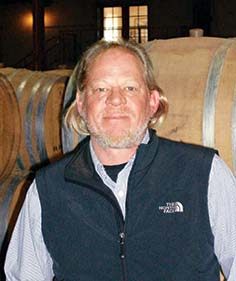 Dan Karlsen, winemaker at Talbott Vineyards, says that Pinot Noir’s tendency towards refermentation led him to adopt filtration, which also prevents Brettanomyces.READ MORE »
Dan Karlsen, winemaker at Talbott Vineyards, says that Pinot Noir’s tendency towards refermentation led him to adopt filtration, which also prevents Brettanomyces.READ MORE »Growing & Winemaking
August 2011Ohmart's New Sustainability Book Available
Wines & Vines columnist Dr. Cliff Ohmart brings reason and clarity to sustainable viticulture in his new book, “View from the Vineyard—A Practical Guide to Sustainable Winegrape Growing.”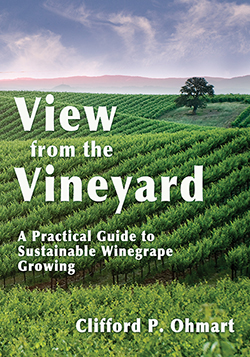 READ MORE »
READ MORE »Growing & Winemaking
July 2011Winemaker Interview: Adam LaZarre
Winemaker Adam LaZarre fell in love with wine while he was serving in the U.S. Navy on Washington state’s Olympic Peninsula in the late 1980s. So much so that when he returned to civilian life, he enrolled in the enology program at California State University-Fresno. He graduated in the mid-1990s and worked at Jekel Vineyards and Constellation Wines in Monterey County and at a custom-crush facility in Lodi.READ MORE »Growing & Winemaking
June 2011Grapegrower Interview: Jerry Lohr
Although Jerry Lohr grew up on a farm in South Dakota, when he settled in California he worked as a developer and homebuilder before making the move back into farming. This time it was winegrapes.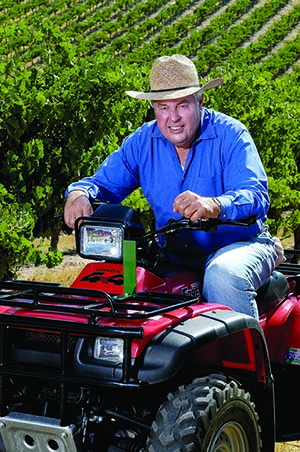 Jerry Lohr.READ MORE »
Jerry Lohr.READ MORE »Growing & Winemaking
June 2011The Secret Life of Feral Yeast
A week of fermenting and punching down Pinot Noir at Crossbarn Winery in Sebastopol, Calif., has left the air heavy with seductive aromas. The fermentation hall reeks of berries and tropical fruit—a sign that the yeast has begun its two-month struggle to transform this year’s harvest from earthy to elegant. Only then will winemaker Greg La Follette wash the last traces of pulp from his hands and call it a day.READ MORE »Growing & Winemaking
June 2011Grapegrowers Switch to Biodiesel
Many grapegrowers and wineries are interested in using biodiesel fuel in their tractors and other farm equipment due to concern for the environment. Tractor manufacturers have responded to them and many other sectors of farming by modifying equipment to handle fuel that contains between 5% and 100% biodiesel.
READ MORE »Growing & Winemaking
June 2011A Home of Their Own
The new Williams Selyem Winery building uses architecture to achieve winemaking goals such as creating Pinot Noir without pumping.Williams Selyem Winery in the Russian River Valley of California completed construction for a spectacular new winemaking and hospitality facility late last year. The 33,000-square-foot structure, half a mile down Westside Road from its leased crushing and fermenting location, now houses all barrel fermenting, aging, bottling and administrative functions in addition to welcoming wine club members for tastings, tours and special events.READ MORE »Growing & Winemaking
May 2011Winemaker Interview: Joel Gott
Joel Gott grew up in the wine business: He’s a fifth-generation winemaker. His grandfather, James Gott, was a winemaker and president of Inglenook in the Napa Valley during the 1960s and 70s, and his father, Cary Gott, founded Montevina in the Sierra Foothills, made wine at Mumm Napa Valley and was president of Sterling Vineyards. Joel started in the business after high school as an apprentice to winemaker Mike Lee at Kenwood Vineyards in Sonoma County. He started Joel Gott Wines in 1995.READ MORE »Growing & Winemaking
April 2011Winemaker Interview: Jeff Cohn
Winemaker Jeff Cohn didn’t start out in the wine industry. In the 1980s he received an associate’s degree in culinary arts from Johnson & Wales University in Providence, R.I., and a bachelor’s degree in hospitality management from Florida International University in Miami. As he toiled in the hospitality industry, Cohn’s interest in wine increased.
READ MORE »Growing & Winemaking
March 2011Grapegrower Interview: Hank Ashby
Located in the hills southeast of Paso Robles, Calif., French Camp Vineyards was developed in the early 1970s by the Miller family, which also owns Bien Nacido and Solomon Hills vineyards in the Santa Maria Valley and two custom-crush wineries on the Central Coast. With more than 1,200 acres under vine, French Camp is noteworthy not only for its array of nearly 30 grape varieties but also for its heavy use of sophisticated mechanical farming techniques.
READ MORE »Growing & Winemaking
March 2011Rolling Out the Kegs
Serving from a keg is one of the oldest ways to deliver wine, but it’s obvious that drawing wine from a traditional wooden keg—even a small one—to fill glasses in a restaurant leads to oxidation and worse.
READ MORE »Growing & Winemaking
February 2011Grapegrower Interview: Deborah Golino
As director of Foundation Plant Services at the University of California, Davis, Deborah Golino is on the front lines of making new grape clones and varieties available to the United States wine industry. A key function of FPS is the importation and quarantine of grapevines, which ensures that nurseries and wineries can get the grape varieties they want without the threat of foreign pests or diseases.Deborah GolinoREAD MORE »Growing & Winemaking
February 2011Native Plants Offer Cover, Too
With the help of the Washington State University extension office, viticulturist Jason Schlagel of Ste. Michelle Wine Estates chose a mix of local grasses and flowers to create beneficial diversity around Columbia Crest Estate.Vitis vinifera may not be a type of weed, but it would be deemed an alien invasive species if it was let loose today. Its domestication and cultivation in North America is a great thing, but too often its economic benefits leave little room for growers to consider its impact on the native ecosystems vinifera is occupying.READ MORE »Growing & Winemaking
February 2011Costs and Benefits of Hang Time
Many winemakers and growers talk about hang time in favorable terms; this was especially true last summer, when cool conditions in many parts of the West Coast saw grapes take longer to achieve the quality parameters that made them worth picking. It was a year that exemplified the conditions in which more hang time benefits grapes by bringing sugars in balance with acids.READ MORE »Growing & Winemaking
February 2011Succeeding With Sparkling
Sparkling wines are a great addition to almost any winery’s lineup of offerings for the tasting room, the wine club and beyond. But sparkling wine production is also a pain in the...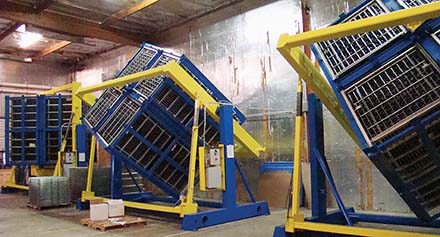 Like most larger sparkling wine producers, 10,000-case Rack & Riddle adopted a gyropalette rather than riddling by hand.READ MORE »
Like most larger sparkling wine producers, 10,000-case Rack & Riddle adopted a gyropalette rather than riddling by hand.READ MORE »Growing & Winemaking
January 2011Mechanization of Vineyards
Bountiful vineyards may be emblems of peace and prosperity, but the in-your-face business of caring for the vines is costly to growers and not without risk to workers.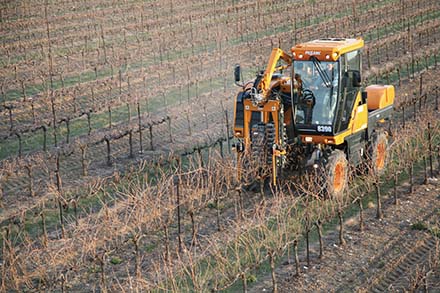 Factors beyond simple economics are pushing growers to mechanize pruning and leaf pulling.READ MORE »
Factors beyond simple economics are pushing growers to mechanize pruning and leaf pulling.READ MORE »Growing & Winemaking
January 2011Grapegrower Interview: Patti Fetzer
Patti Fetzer grew up in the wine business. Her late father, Barney Fetzer, founded Fetzer Vineyards in Mendocino County in 1968, and Patti and her 10 siblings worked in all areas of the business. After the family sold the business in 1992, she remained in the industry, eventually founding Patianna Organic Vineyards outside Hopland, Calif., in 2003. Her 126-acre property, in the Fetzer family since 1983, has been certified organic since 1987. About 75 acres are planted to Sauvignon Blanc and Chardonnay. Fetzer has been married since 2006 to Gregg Hileman, who worked at Fetzer’s Valley Oaks facility in the 1980s and is general manager of Patianna.READ MORE »Growing & Winemaking
January 2011Vintage 2010
With the help of farm advisers and industry professionals across the United States and Canada, Wines & Vines publishes an annual report about the North American winegrape harvest. This year, the format has been streamlined to relay the essence of one of the most irregular growing seasons on record.
READ MORE »Growing & Winemaking
December 2010Getting the MOG Out
Roland Kruger watches whole clusters fall into the destemmer at Wild Goose Vineyards. Photo by Peter MithamOne of the best ways to keep juice and must clean is to make sure nothing else gets into the bins when the grapes are harvested; but invariably, something will always tag along. If you’re using manual harvesting, there are always parts of the stem and leaves that somehow reach the bin. Soil, rocks and sometimes even small animals hitch along for the ride to the crush pad. And critters definitely don’t belong in your wine—even if it’s a critter wine.READ MORE »Growing & Winemaking
December 2010Winemaker Interview: Kris Curran
When winemaker Kris Curran was growing up in California’s Santa Ynez Valley, she spent a lot of time working with animals. But by the time she earned a degree in animal science at California Polytechnic University in San Luis Obispo in 1994, she knew she wanted to be a winemaker. Curran subsequently earned another bachelor’s degree—this one in enology—from California State University, Fresno, in 1996.Kris CurranREAD MORE »Growing & Winemaking
December 2010Vineyard Strikes a Balance
Doug Fletcher harvested grapes for legendary winemaker Martin Ray four decades ago. “He taught me to challenge long-held beliefs, yet trust what I’d learned about the scientific method,” says Fletcher, VP of winemaking for the Terlato Wine Group. Like Ray, Fletcher dared to contest an Old World myth—that extraordinary wines share a common soil type—with imaginative and painstaking fieldwork.READ MORE »Growing & Winemaking
October 2010Winemaker Interview: David Adelsheim
When David Adelsheim established Adelsheim Vineyard in Oregon’s Chehalem Mountains, he was something of a pioneer. It was 1971, and a few people (like David Lett, Dick Erath and Bill Blosser) had planted winegrapes around the Willamette Valley, but not in the Chehalem Mountains. Adelsheim had no background in the wine business. He majored in German literature in Frankfurt, Berlin, and at Portland State University, and he had worked in personnel management in the Army. But he got advice from Oregon’s other early vintners and settled on what he thought was a suitable 19-acre parcel.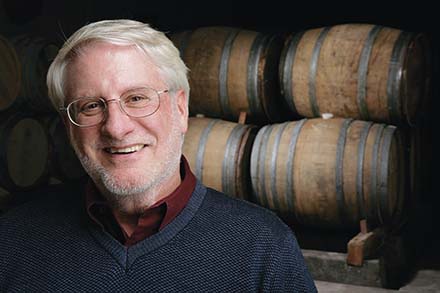 David AdelsheimREAD MORE »
David AdelsheimREAD MORE »Growing & Winemaking
September 2010Oak Adjuncts in Red Ferments
The glamor shots (such as they are in the wine craft) showing cellars with row upon row of barrels convey to consumers the romantic notion of élevage, a French term that literally means the elevation or upbringing of wine. The role oak plays in the final sensory experience of the drink seems inextricable from the use of barrels. The toast, the tannins from the wood and the dynamic interaction with the environment that oak allows all contribute to the experience of the wine through the eyes, nose and palate of the drinker.
READ MORE »Growing & Winemaking
August 2010Winemaker Interview: Greg Kitchens
As a Napa Valley native, winemaker Greg Kitchens developed an early interest in wine, eventually earning a biochemistry degree from the University of California, San Diego, in 1998. He worked at Beaulieu Vineyard and Sebastiani Vineyards before joining Don Sebastiani & Sons in 2001. Kitchens has been the head winemaker there since 2009, and he works with a wide range of brands, many of them sealed with alternative closures.
READ MORE »Growing & Winemaking
August 2010Post-Bottling Winemaking
In Wines & Vines’ closures issue last year, I described how the wine industry is beginning to grapple with the issue of oxygen management, focusing on the ongoing research initiative begun in 2007 by synthetic closure company Nomacorc to study the impact of oxygen in winemaking and post-bottling. In this article, we’ll look at some of the newest results from these studies and discuss their significance.
READ MORE »Growing & Winemaking
June 2010Almost Satisfied With Sprayers
For many aspects of winemaking, growers and winemakers seek new equipment and supplies that can improve their products and simplify their work. When it comes to vineyard sprayers, however, many growers seem quite happy with the equipment they’re using.While suppliers tout new technologies such as electrostatic sprayers and GPS navigation, growers told Wines & Vines they are most interested in reliable performance and minimal, easy maintenance.READ MORE »Growing & Winemaking
June 2010Grapegrower Interview: Kent Waliser
As general manager of Sagemoor Vineyards in Pasco, Wash., Kent Waliser oversees about 900 acres of vineyard in the Columbia Valley and Wahluke Slope AVAs. The company sells to 75-plus wineries, ranging from large (Ste. Michelle Wine Estates, which buys about 30% of Sagemoor’s production) to smaller (L’Ecole No. 41, Reininger, DeLille). Sagemoor is one of Washington’s largest growers without an associated winery.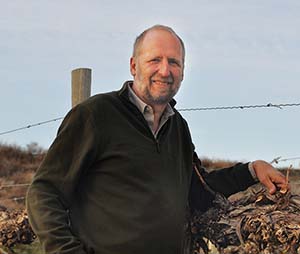 Kent WaliserREAD MORE »
Kent WaliserREAD MORE »Growing & Winemaking
June 2010Time for a Canopy Sprayer Tune-Up
Many problems associated with pesticide application can be prevented if sprayers are calibrated and adjusted correctly. Poorly calibrated sprayers can lead to less than ideal application. Over- application causes residue concerns and may result in crop loss due to phytotoxicity; it is also responsible for economic loss, because more spray is applied than is needed. Under-application or inconsistent application, on the other hand, have an economic cost due to crop loss from poor disease- and insect-control, as well as lower crop quality.
READ MORE »Growing & Winemaking
June 2010First Steps in Winery Flooring
The soft-soled shoes, the smooth finish of the cellar floor and a bit of water from whatever had been going on before my arrival: It was the recipe for a classic slip-and-fall, the black slapstick found in writs and court filings. I was lucky, however, and kept my balance.
READ MORE »Growing & Winemaking
May 2010Understanding Congeners in Wine
Congeners (Latin for “born together”) live up to their name. They’re the inevitable but often neglected siblings of an alcoholic fermentation. As yeasts ferment the sugars from must or any other source to ethanol and carbon dioxide, they also deliver an array of other compounds, appropriately called congeners. They’re yeast’s supplement to the flavor complexity of wine that complements the contributions of the grapes themselves.
READ MORE »Growing & Winemaking
May 2010Winemaker Interview: Josh Jensen
When Josh Jensen picked a site in the Hollister, Calif., area to establish a vineyard, it was for one reason: limestone. After earning a master’s degree in anthropology at Oxford University, Jensen spent a couple of harvests in Burgundy—one at Domaine de la Romanée-Conti, and one at Domaine Dujac. He began to believe, as the Burgundians do, that limestone is essential to growing world-class Pinot Noir and Chardonnay.
READ MORE »Growing & Winemaking
May 2010The Year of the Harvester?
The low rumble of a hydrostatic transmission sets Victor Sanchez’s reflexes in motion. From the air-conditioned cabin of a multi-purpose tractor, he adjusts the conveyor belt, aligns the tension rods, releases the parking brake and nudges the gear lever into drive. The Pellenc 8590 over-the-row tractor pitches headlong down a column of Hahn Winery Syrah on an October morning.READ MORE »Growing & Winemaking
May 2010Do Oil Sprays Delay Ripening For Winegrapes?
Using horticultural oils to control powdery mildew and suppress grape leafhopper, mite, scale and mealybug is becoming a popular tool of integrated pest management (IPM) in vineyards, but Laura Breyer of Breyer’s Vineyard IPM Service in Windsor says that questions have been raised about the oil’s impact on grape ripening, yield and quality. “Some winemakers have become reluctant to allow their growers to use oils because of these concerns,” she says. A recent report from the Central Coast—and another from the North Coast, in which she participated—seem to dispute those fears.
READ MORE »Growing & Winemaking
April 2010Winemaker Interview: Barry Gnekow
During more than 30 years of winemaking, Barry Gnekow (pronounced NEE-koh) has worked with a broad range of California wineries and has been a pioneer in technologies such as reverse osmosis for alcohol removal and ultra-filtration. A longtime winemaker for J. Lohr Winery in San Jose, Calif., he developed the first widely sold dealcoholized wine, Ariel. After leaving J. Lohr and Ariel, he opened Gnekow Family Winery, a custom-crush facility in Collegeville, in the Lodi area.
READ MORE »Growing & Winemaking
April 2010Tanks Adapt to the Times
Wineries cut their orders for tanks dramatically last year, as economic retrenchment became the order of the day and consumer tastes shifted down. This year, suppliers are bringing forward tanks that fit wineries’ leaner budgets but equally demanding criteria.READ MORE »Growing & Winemaking
April 2010Winery Shows Off Flash Extraction
Flash-Détente technology, designed to increase extraction of color from red grapes while minimizing seed tannins, was developed in France in the late 1990s. But the machinery has only recently made its way to the United States. In fall 2009, during harvest, a Flash-Détente system was installed at Monterey Wine Co. in King City, Calif. The results of the custom-crush winery’s first experiments with the system were unveiled at a presentation and tasting at the facility in mid-February.The Flash-Détente unit being trialed at California's Monterey Wine Co. custom-crush cost about $2 million installed.READ MORE »Growing & Winemaking
March 2010Effects of Beneficial Cover Crop
In the summer of 2007, members of the Central Coast Vineyard Team (CCVT) staff met with David Gates and Caleb Mosley of Ridge Vineyard to discuss the importance, expense and effectiveness of planting a beneficial insect habitat as a vineyard cover crop. Seeds for these blends can cost upward of $20 per pound, which can be extremely costly to integrate into a cover program, yet they have immeasurable potential to aid in balancing pest populations. This discussion raised three questions:
READ MORE »Growing & Winemaking
March 2010Alternatives to Wood Posts
Many a summer afternoon spent mending fences on my brother’s dairy farm taught me the value of cedar posts. Sometimes we would strip bark off the logs that would eventually be formed into stakes, on which we hung electric wire to keep the cattle in. The lifespan was a dozen years, maybe more. There simply wasn’t anything as durable when it came to fenceposts—certainly nothing as cheap as logs from my brother’s own property.
READ MORE »Growing & Winemaking
March 2010Grapegrower Interview: PAUL JOHNSON
As general manager of J & L Farms, Paul Johnson farms about 3,000 acres of vineyards in Monterey County, Calif. Two large vineyards in the southern part of the county—San Lucas Vineyards and Paris Valley Ranch, where the vines are set up for substantial mechanization—account for much of that acreage. The company also farms La Estancia in the Santa Lucia Highlands, where more hand labor is the norm.
READ MORE »Growing & Winemaking
February 2010Italian Trade Show Draws 51,545
Tough economic times scaled back the number of exhibitors attending the 23rd edition of Salone Internazionale delle Macchine per l’Enologia e l’Imbottigliamento (SIMEI), Milan’s biennial exhibition of winemaking and bottling equipment, but visitors who traveled from around the world in late November to see Europe’s latest innovations in winery gear weren’t disappointed.
READ MORE »Growing & Winemaking
January 2010A Pump for Every Purpose
While winemakers rarely show off their pumps to visitors as they do barrels and sorting tables, conscientious cellar masters recognize pumps’ important roles in maintaining wine quality. Today they are choosing them with greater care, and from a wider range of pumping technology.
READ MORE »Growing & Winemaking
January 2010Seed Removal Remains Challenging
About 18 years ago I had a rare and candid conversation with Julio Gallo. During a lunch break, when Gallo was mixing the ingredients for a tossed salad, I asked him if he had ever thought about the effects of seeds on the tannin structure of red wines.
READ MORE »Growing & Winemaking
January 2010Hanzell and ML 34
Induced malolactic fermentations and their instigator, ML 34, are celebrating a 50th birthday, and it’s a good time to reminiscence about seminal investigations done on the venerable microbe, Oenococcus oeni, at Hanzell Winery and the University of California, Davis.
READ MORE »Growing & Winemaking
December 2009To Blow Up or Down?
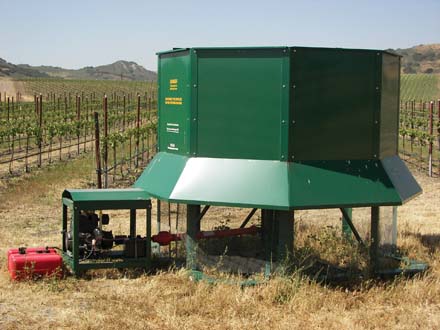 Rather than pulling warm air down to the vineyard floor, the Selective Inverted Sink whisks cold air away from susceptible vines.
Rather than pulling warm air down to the vineyard floor, the Selective Inverted Sink whisks cold air away from susceptible vines.Until global climate change warms things up a lot more, grapegrowers will still have to deal with frost. Certain techniques that growers once used are becoming difficult to implement, but alternative approaches are proving useful for many others. For example, some growers are enthusiastic about surface-mounted fans that blow cold air up and out of vineyards.
READ MORE »Growing & Winemaking
December 2009Lighter Touch With Barrels
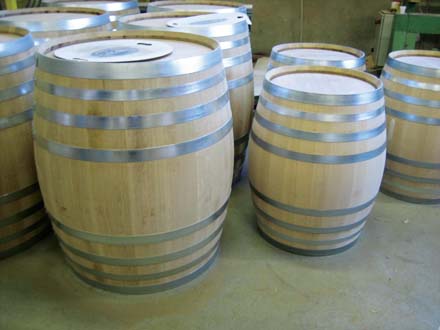 At twice the size of a regular barrel, 500-plus-liter puncheons provide less contact between wine and oak, resulting in a cleaner, fresher style preferred by many Pinot winemakers.
At twice the size of a regular barrel, 500-plus-liter puncheons provide less contact between wine and oak, resulting in a cleaner, fresher style preferred by many Pinot winemakers.There’s way too much domestic Pinot Noir out there that could easily be mistaken for Syrah, the man on the other end of the phone is saying. “It’s over-extracted and over-oaked.” His job, as he sees it, is to help winemakers precisely match barrel to grape variety -- and beyond that, to match barrel to each winemaker’s individual style. His name is Paul Frommelt, sales director for barrel makers Trust, Treuil, Marc Kennel and A.P. John Coopers.
READ MORE »Growing & Winemaking
November 2009Many Roads to Mouthfeel
Mouthfeel is big business. In recent years, the texture of wine has taken its place right alongside aroma and flavor as a major concern for wine writers, winemakers, wine marketers and, of course, vendors of specialized products designed to aid and abet. There’s even a Mouth-Feel Wheel, modeled after the Aroma Wheel, developed by researchers at the University of Adelaide and the Australian Wine Research Institute.READ MORE »Growing & Winemaking
November 2009Winemaker Interview: Steve Glossner
Steve Glossner’s original goal wasn’t to become a winemaker. He was studying for a business degree at Cornell University in Ithaca, N.Y., when he happened upon Finger Lakes wines. After a stint in a wine shop, he worked as a cellar rat in California and New Zealand before doing graduate work in enology at California State University, Fresno. It was while studying at Fresno that he discovered Paso Robles, where he’s made his mark in the wine industry.
READ MORE »Growing & Winemaking
October 2009Using Staves as Add-Ins
Just as the current recession has forced vintners to try new pricing and marketing strategies to cope with diminished demand for fine wines, it also has prompted them to innovate in their cellars to accomplish cost savings. The challenge is not compromising quality in the process.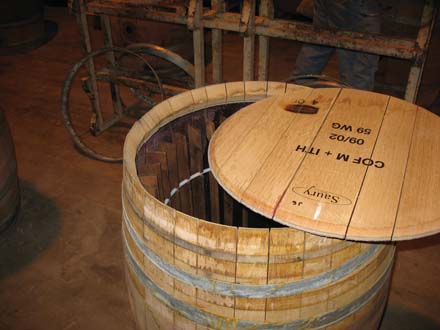 A neutral barrel is outfitted with toasted, barrel-length oak staves, which impart an oak flavor that resembles extraction from a new barrel.READ MORE »
A neutral barrel is outfitted with toasted, barrel-length oak staves, which impart an oak flavor that resembles extraction from a new barrel.READ MORE »Growing & Winemaking
October 2009New Path to Tartrate Control
Electro-dialysis as an alternate method for cold stabilization of wine has been gaining ground in California and elsewhere. According to one industry estimate, 1.5 billion gallons of wine have gone through this process in several countries -- most of them in Europe, and perhaps 5 million gallons in California. Much of the fanfare about the new technology has focused on the potential for major energy savings, since electro-dialysis requires substantially less electricity than traditional bulk chilling. But emerging research indicates that electro-dialysis is at least as good a method in terms of wine quality, and in some cases a likely improvement.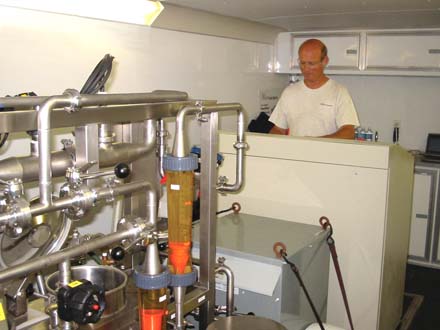 Cliff Burmester, Winesecrets' senior STARS technician, operates an ED-800 STARS unit mounted in a trailer. Electro-dialysis removes the components of potassium bitartrate.READ MORE »
Cliff Burmester, Winesecrets' senior STARS technician, operates an ED-800 STARS unit mounted in a trailer. Electro-dialysis removes the components of potassium bitartrate.READ MORE »Growing & Winemaking
September 2009How French Are French Barrels?
In an effort to ensure the origin of wood that is used to make oak barrels, a French cooperage trade association has submitted a charter to the government to create "a common rule and a coherent definition" of forest designations. The charter is designed to break old habits in the cooperage industry and set more clear standards for wood origins.READ MORE »Growing & Winemaking
September 2009Keep Instruments Accurate
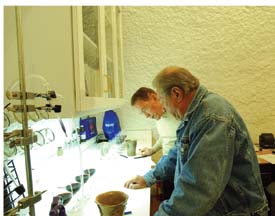 William Jarvis and Dimitri Tchelistcheff confer in the lab at Jarvis Winery in the Napa Valley.
William Jarvis and Dimitri Tchelistcheff confer in the lab at Jarvis Winery in the Napa Valley.Though winemakers and enologists use many instruments, they don't always pay as much attention to them as they might. Most instruments require periodic maintenance and calibration, but that's easy to forget during the crush of harvest season.
READ MORE »Growing & Winemaking
August 2009Winemaker Interview
READ MORE »Growing & Winemaking
August 2009Tartrate Stabilization in a Jug
Stabilizing commercial wines to prevent tartrate precipitation (which is harmless, but cosmetically unappealing) takes many forms, most of them involving electricity and/or refrigeration and/or lots of water. There's traditional bulk chilling, and chilling speeded up by "seeding" a tank with bitartrate crystals to get things going, and flash chilling achieved by running wine through a narrower cylinder for a shorter time, and more recent interest in tartrate removal via polymer membranes and electro-dialysis. And there's always the time-honored solution of leaving the wine in an unheated cellar in Burgundy during the winter.READ MORE »Growing & Winemaking
August 2009Shopping for Refractometers
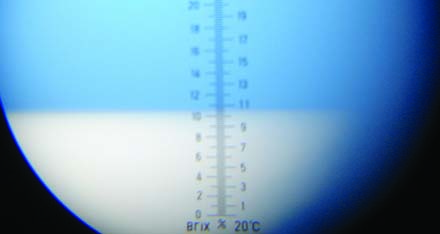 Most winegrape growers use refractometers to measure the amount of sugar in juice, but technically the instruments calculate how quickly light travels through liquid, compared to water.READ MORE »
Most winegrape growers use refractometers to measure the amount of sugar in juice, but technically the instruments calculate how quickly light travels through liquid, compared to water.READ MORE »Growing & Winemaking
July 2009When the Smoke Cleared
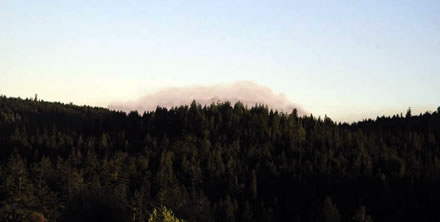 Smoke from the Mendocino Lightning Complex wildfire climbs the hillside near Londer Vineyards. Wildfires burned across California in June 2008.
Smoke from the Mendocino Lightning Complex wildfire climbs the hillside near Londer Vineyards. Wildfires burned across California in June 2008.
PHOTO:Larry LonderAre these the best or worst of times for Mendocino County winemaker Larry Londer? Recently, his 2007 Londer Vineyards Paraboll Pinot Noir and Corby Chardonnay earned top marks from editors at Wine Spectator. At the same time, he described 2008 as his most challenging vintage ever.READ MORE »Growing & Winemaking
July 2009Foundation for a Quality Vineyard
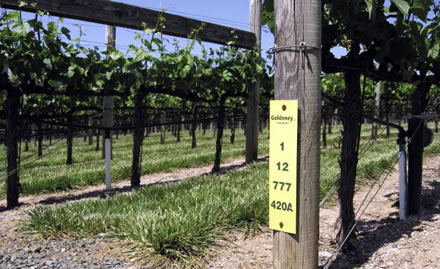 A marker on the end of this vineyard row at Goldeneye winery in the Anderson Valley signifies that Pinot Noir clone 777 is budded to 420A rootstock, which is a cross of Vitis berlandieri and V. riparia. Most of the modern vineyards in California use hybrid rootstocks such as 420A.Rootstocks are analogous to the foundation and basement under a building--they provide support and stability, the utilities enter there, and it is also a place to store things. Most of the time neither is particularly visible or lauded, but both are extremely important to the wellbeing and longevity of their respective tops.READ MORE »
A marker on the end of this vineyard row at Goldeneye winery in the Anderson Valley signifies that Pinot Noir clone 777 is budded to 420A rootstock, which is a cross of Vitis berlandieri and V. riparia. Most of the modern vineyards in California use hybrid rootstocks such as 420A.Rootstocks are analogous to the foundation and basement under a building--they provide support and stability, the utilities enter there, and it is also a place to store things. Most of the time neither is particularly visible or lauded, but both are extremely important to the wellbeing and longevity of their respective tops.READ MORE »Growing & Winemaking
July 2009Win-Win Grape Contracts
In the not-so-good old days, growers and wineries often seemed like adversaries, and old timers remember the era when an attitude of us vs. them ruled wine regions like Napa Valley. Winegrape buyers who pay by the acre, rather than the ton, have more say about farming practices.
Winegrape buyers who pay by the acre, rather than the ton, have more say about farming practices.
PHOTO:Sheldrake Point VineyardREAD MORE »Growing & Winemaking
July 2009Grapegrower Interview
Amigo Bob Cantisano, a ninth - generation Californian, is widely regarded as one of the state's most important proponents of organic farming. He's been farming organically in the Sierra Foothills since 1974; his current operation, Heaven and Earth Farm, is in Nevada County. But it's in his work as an adviser that his influence has been most keenly felt. A co - founder of California Certified Organic Farmers (CCOF), the nation's oldest organic certification organization, Cantisano founded Organic Ag Advisers in 1987. Since then, he's consulted with more than 600 farmers who grow winegrapes, vegetables, fruits, grains and other crops. He's even shared his expertise with the World Bank, the government of Costa Rica and the California Department of Transportation. Cantisano goes by the nickname Amigo, a nickname given to him in high school.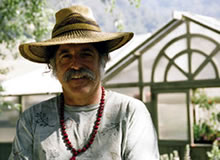 Amigo Bob Cantisano takes a moment to reflect at Skipstone Ranch, where he collaborated with winery and vineyard staff to achieve CCOF certification for the estate above Alexander Valley.
Amigo Bob Cantisano takes a moment to reflect at Skipstone Ranch, where he collaborated with winery and vineyard staff to achieve CCOF certification for the estate above Alexander Valley.
PHOTO:Skipstone RanchREAD MORE »Growing & Winemaking
July 2009Robot Pruner Shows Its Stuff
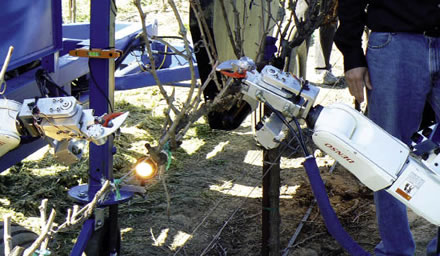 Vision Robotics' "Intelligent Robotic Vineyard Pruner" (seen approaching a vine) demonstrates precision cutting at Sutter Home's Delta Ranch.
Vision Robotics' "Intelligent Robotic Vineyard Pruner" (seen approaching a vine) demonstrates precision cutting at Sutter Home's Delta Ranch.Grower uncertainty about future vineyard labor sources and costs has motivated development of sophisticated vineyard mechanization tools and systems in recent years. About 70 vineyard professionals gathered this spring with avid interest at Sutter Home's Delta Ranch vineyard for a demonstration of the "Intelligent Robotic Vineyard Pruner." It's the latest version of a project under development by San Diego-based Vision Robotics Corp., with assistance from several California vineyard industry investors.
READ MORE »Growing & Winemaking
May 2009From the Ground Up
It is springtime in the Salinas Valley, and a half-dozen vineyard managers have gathered around a soil ripper the size of a freighter. They watch as a brightly painted tractor lumbers across a broccoli field, grappling the earth with two 30-foot-long tread belts that are as tall as a grown man.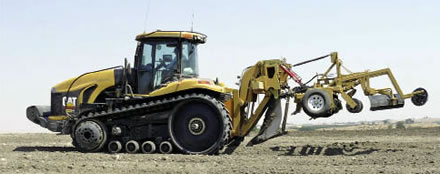 The Caterpillar Challenger (above) is fitted with a Vibrosoiler vibrating ripper and mounder.READ MORE »
The Caterpillar Challenger (above) is fitted with a Vibrosoiler vibrating ripper and mounder.READ MORE »Growing & Winemaking
May 2009Clarksburg Seeks Consumer Awarness
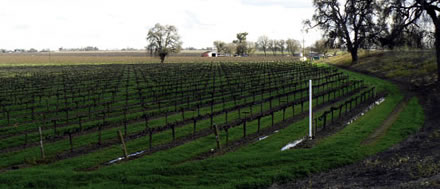 This typical Clarksburg vineyard is planted in fertile Delta soil protected by the adjacent levee on the right.The Clarksburg American Viticultural Area (AVA) covers 57,000 acres in Sacramento and Yolo Counties with 17,000 acres of vineyards planted between levees lining the rivers and sloughs of this California Delta region. With warm days and cool nights, the Delta's cooling influence enables production of grape varieties not typically grown in California's inland regions. The area grows 25 varieties, and plantings of Pinot Noir and Pinot Grigio have increased significantly since 2006. Production is nearly 70% white varieties, led by Chardonnay, then Pinot Grigio, Sauvignon Blanc and Chenin Blanc. The percentage of red varieties is catching up, led by Merlot, then Pinot Noir, Cabernet Sauvignon and Petite Sirah.READ MORE »
This typical Clarksburg vineyard is planted in fertile Delta soil protected by the adjacent levee on the right.The Clarksburg American Viticultural Area (AVA) covers 57,000 acres in Sacramento and Yolo Counties with 17,000 acres of vineyards planted between levees lining the rivers and sloughs of this California Delta region. With warm days and cool nights, the Delta's cooling influence enables production of grape varieties not typically grown in California's inland regions. The area grows 25 varieties, and plantings of Pinot Noir and Pinot Grigio have increased significantly since 2006. Production is nearly 70% white varieties, led by Chardonnay, then Pinot Grigio, Sauvignon Blanc and Chenin Blanc. The percentage of red varieties is catching up, led by Merlot, then Pinot Noir, Cabernet Sauvignon and Petite Sirah.READ MORE »Growing & Winemaking
April 2009Tanks for Small Lots
Although winemaking tanks have been around for millennia, clever manufacturers have devised many interesting innovations that better extract color and flavor during fermentation with greater consistency, convenience and safety. Portable, stackable tanks like these front-draining models from Westec are growing increasingly popular as winemakers move to small-lot fermentations.READ MORE »
Portable, stackable tanks like these front-draining models from Westec are growing increasingly popular as winemakers move to small-lot fermentations.READ MORE »Growing & Winemaking
April 2009Jonathan Pey
Jonathan Pey has worked in the wine industry for nearly 25 years, but for most of that time, he was marketing wine rather than making it. He's been a sales manager for Kobrand Corp., worked with Schramsberg founder Jack Davies on a venture in Portugal, run the international division for Seagram Chateau & Estate Wines, helped establish a joint venture between Mondavi and Rosemount, and was general manager of Penfolds' North American business. In 2005, he left Penfolds to focus on the wine venture he started with his wife, Susan Pey, corporate wine director of the Il Fornaio Restaurant Group.READ MORE »Growing & Winemaking
March 2009Viginie Bourgue
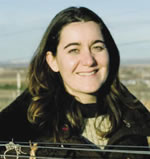 Virginie Bourgue
Virginie BourgueVirginie Bourgue's business card for Cadaretta Wines in the Walla Walla Valley AVA reads "winemaker,'' but she also has a strong background in viticulture. A native of France, she earned her bachelor's degree in viticulture in Avignon, then a master's in enology from the University of Sciences in Reims. She worked at a number of viticulture and winemaking jobs in France, mostly in the Champagné region, before moving to Washington state in 2002 for an internship at Chateau Ste. Michelle.
READ MORE »Growing & Winemaking
March 2009How Good Are Wine Labs?
It's rare that a dispute over a highly technical piece of wine analysis causes a stir in the industry, but the recent flap over the validity of the Adams-Harbertson tannin assay has been quite the exception.READ MORE »Growing & Winemaking
March 2009Mixing It Up = Sustainable
I have only indicated these matters on general lines and, for some time to come, these should serve as the foundation for the most varied experiments, such as should lead to most striking results. -- Rudolf Steiner
 Kevin Chambers.
Kevin Chambers.That commendation from the close of Rudolf Steiner's lectures on agriculture, the basis of what is known today as Biodynamic viticulture, is what Kevin Chambers puts forward as the key to moving the grape and wine industry closer to a sustainable model.
READ MORE »Growing & Winemaking
February 2009Water conservation by short, frequent irrigations
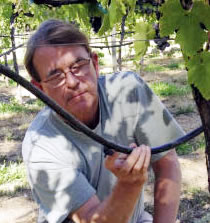 Bill Nachbaur inspects the irrigation system at Alegría Vineyards in Sonoma County.
Bill Nachbaur inspects the irrigation system at Alegría Vineyards in Sonoma County.We use drip irrigation, which meters out a limited amount of water to each vine, so we were already in conservation mode when the State Water Resources Control Board last year mandated that Sonoma County reduce water use by 15% to be sure there was sufficient water in Lake Mendocino to support the fall Chinook salmon run in the Russian River. As part of the Sonoma County Water Agency's effort to reduce water consumption in the county by all users, the agency provided grower education at monthly Integrated Pest Management meetings held by the Sonoma County Winegrape Commission. Suggested practices included irrigating more frequently but for shorter intervals to ensure water did not percolate below the root zone.
READ MORE »Growing & Winemaking
February 2009How the mildew model conserves fuel, materials
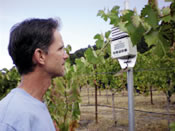 John Kiger checks the gauges of the mildew tracking station at Kiger Family Vineyards.
John Kiger checks the gauges of the mildew tracking station at Kiger Family Vineyards.During the past couple of seasons I have been transitioning from conventional to organic farming practices. In this transition I anticipated a significant increase in the costs of spraying for powdery mildew control. Organic controls for powdery mildew typically require spraying every 7-14 days, as opposed to every 14-21 days using conventional fungicides. Although organic control programs tend to use less expensive fungicide materials, labor, equipment and diesel costs increase significantly with more frequent spraying.
READ MORE »Growing & Winemaking
February 2009Wannabe Winemaker Thinks Ahead
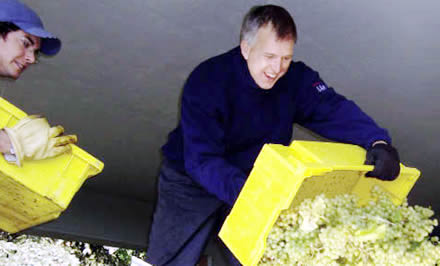 Ira Kreft (right) helps load clusters of Chardonnay into the press at L. Mawby Vineyards.While the financial industry was awash in bad news last fall, Chicago investment manager Ira Kreft found himself washing lugs 300 miles from his office. At age 50, he was participating in an internship of sorts--two unpaid, self-solicited weeks of hard harvest labor in two northern Michigan wineries--experiences intended to help him transition from the world of finance to vineyards and wineries.READ MORE »
Ira Kreft (right) helps load clusters of Chardonnay into the press at L. Mawby Vineyards.While the financial industry was awash in bad news last fall, Chicago investment manager Ira Kreft found himself washing lugs 300 miles from his office. At age 50, he was participating in an internship of sorts--two unpaid, self-solicited weeks of hard harvest labor in two northern Michigan wineries--experiences intended to help him transition from the world of finance to vineyards and wineries.READ MORE »Growing & Winemaking
February 2009Putting Plastic to Work
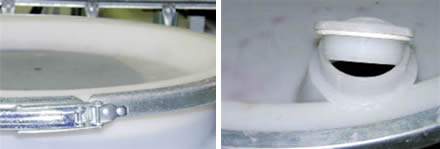 The Flextank clamp manway (left) seals the vessel as securely as a barrel. Meanwhile, the screwed fitting in the manway (right) allows access to the container's contents in the same fashion as a barrel's bung closure.
The Flextank clamp manway (left) seals the vessel as securely as a barrel. Meanwhile, the screwed fitting in the manway (right) allows access to the container's contents in the same fashion as a barrel's bung closure.Premium wineries are beginning to appreciate the utility of plastic tanks for various aspects of production. This article continues the discussion begun in "Advantages of Plastic" (Wines & Vines, January 2009). First, I'll review innovations that are occurring with plastic tanks, then I'll explore how wineries can reference these tanks in promotional information--as well as on the bottle.
READ MORE »Growing & Winemaking
February 2009New Methods to Limit Urea
The issues of urea and ethyl carbamate have been hovering over the wine industry like a little cloud for several years now. Urea, a minor byproduct of yeast metabolism, can combine with ethanol to form urethane--also known as ethyl carbamate or EC--a known carcinogen in animals and a likely carcinogenic danger for humans as well. The stubborn part of this problem--the reason it won't go away quietly--is that some urea is produced in every fermentation. Some of that urea always transforms itself into EC, and once it's there, it's devilishly hard to get rid of.READ MORE »Growing & Winemaking
January 2009A Perfect Storm
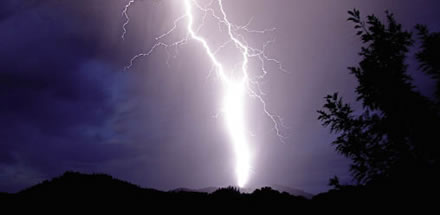 More than 6,000 lightning strikes sparked 2,000 fires in 26 California counties June 20.
More than 6,000 lightning strikes sparked 2,000 fires in 26 California counties June 20.
PHOTO: David Scollin
When a thunderstorm rolls in, Marie Greenhall, a U.S. Forest Service lookout, can't keep track of all the lightning. Because cloud-to-ground lightning bursts ignite 70% of all western wildfires, she plots the direction and distance of strikes that singe the woodlands within a 60-mile radius of Anthony Peak.READ MORE »Growing & Winemaking
January 2009Blown Away
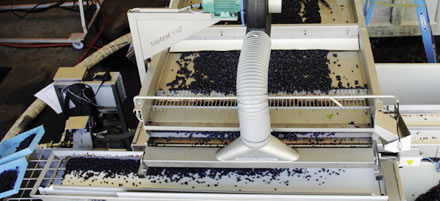 All red grapes fermented by Provenance Winery go through the Mistral 140 automatic sorter, says winemaker Chris Cooney, who installed the device at the Rutherford, Calif., winery in 2007.
All red grapes fermented by Provenance Winery go through the Mistral 140 automatic sorter, says winemaker Chris Cooney, who installed the device at the Rutherford, Calif., winery in 2007.It's not news that winemakers are adopting sorting tables to remove raisins, shot berries, jacks and other unwanted matter before fermentation. There's little need to explain to winemakers the value of fermenting clean fruit, and Tim Patterson covered the subject of sorting with manual tables a couple of months ago in Wines & Vines ("Gentler is Better," November 2008). More and more high-end wineries make the sorting process a necessary part of their regimen. But some also have been discouraged by the need to hire or assign a dozen or more people to this tedious task.
READ MORE »Growing & Winemaking
January 2009KARL WENTE
Karl Wente, 31, is the fifth-generation winegrower to work at his family's Livermore Valley winery, which celebrated its 125th anniversary earlier this year. Wente Vineyards produces about half a million cases per year, but Wente is particularly enthusiastic about the winery-within-a-winery--dubbed the Small Lot Winery--created in 2002 to produce small lots from selected vineyard blocks. The Small Lot Winery also is the home of Nth Degree Wines, the Wentes' effort to make the best wines possible from their 3,000 acres of vineyards in Livermore Valley and Monterey County's Arroyo Seco appellation.READ MORE »Growing & Winemaking
January 2009Advantages of Plastic
For decades the wine industry has used concrete tanks, stainless steel tanks of all sizes, large and small wood tanks made of trees ranging from redwood to oak to chestnut, and a few glass-lined tanks. Fiberglass tanks have not been widely used in the United States because of concerns about oxygen transfer and the cost of labor for construction, but several Italian companies manufacture these types of tanks for use in Europe. Plastic tanks did not make any substantive penetration into the wine industry until the mid-1980s.
READ MORE »Growing & Winemaking
January 2009Grower Interview Jeff Newton
With his partners in Coastal Vineyard Care Associates, Jeff Newton is responsible for farming 35 properties encompassing about 2,000 acres in Santa Barbara County, mostly in the Santa Ynez Valley and Santa Rita Hills. His clients include such well-known properties as Jonata, Stolpman, Fiddlestix and Vogelzang. Newton founded Coastal Vineyard Care in 1984 after working first as an agricultural economist in Sacramento and then for a large grower in the Santa Maria Valley.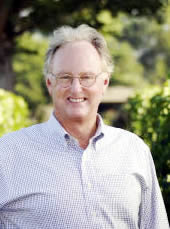 Jeff NewtonREAD MORE »
Jeff NewtonREAD MORE »Growing & Winemaking
January 2009Checklist for Conservation
Early this year fuel prices reached new highs, a dry spring heightened concerns about water supplies, and materials costs for vineyards had nearly doubled for some inputs. These trends make resource conservation even more important for grapegrowers. Fortunately, growers have a number of options available to them to conserve resources, save money and still produce a high-quality grape crop.READ MORE »Growing & Winemaking
December 2008Better Fit for the Vineyard
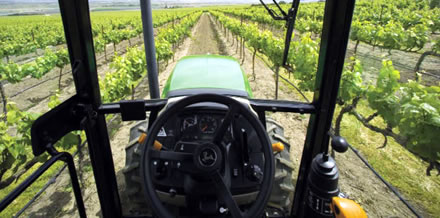 John Deere manufactures the 5D, 5E, 5E Limited and 5M Series--a line of general utility tractors, which range from 45 to 105 engine horsepower.The numerous introductions of tractors especially useful for vineyards in recent years aren't just a coincidence. Tractor manufacturers are paying more attention to vineyard applications as they realize it's a profitable market, and some of the biggest names in farm equipment have introduced several new or enhanced models since Wines & Vines last covered this topic in May.READ MORE »
John Deere manufactures the 5D, 5E, 5E Limited and 5M Series--a line of general utility tractors, which range from 45 to 105 engine horsepower.The numerous introductions of tractors especially useful for vineyards in recent years aren't just a coincidence. Tractor manufacturers are paying more attention to vineyard applications as they realize it's a profitable market, and some of the biggest names in farm equipment have introduced several new or enhanced models since Wines & Vines last covered this topic in May.READ MORE »Growing & Winemaking
December 2008The Forest or the Trees?
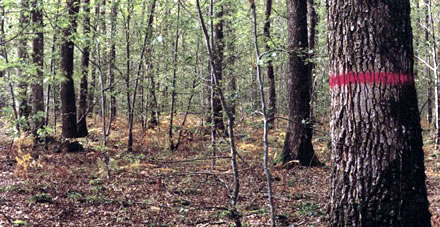 For decades French barrelmakers advertised the forests where their world-famous oak originated. Recently, however, cooperages have begun focusing more on the grain of the wood than the place it came from when marketing their products.
For decades French barrelmakers advertised the forests where their world-famous oak originated. Recently, however, cooperages have begun focusing more on the grain of the wood than the place it came from when marketing their products.
PHOTO: Taransaud Tonnellerie'We don't work on a forest, we work on the size of the grain--that's a revolution," Nicholas Mähler-Besse of Tonnellerie Radoux told Wines & Vines in early October at his cooperage near Cognac, France. His words echoed those of several cooperage spokesmen across France, including the Burgundy region.READ MORE »Growing & Winemaking
December 2008Going Mobile
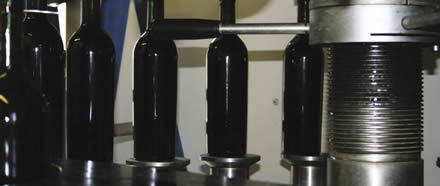 Wine bottles are filled inside one of five mobile trailer units owned by Halsey Bottling, which has equipment that can output up to 3,500 cases per day.Just as grapes don't stop ripening during a credit crunch, wine needs to be bottled regardless of whether a premium bottling line is in a winemaker's budget. For winery owners wary of investing their hard-earned capital in machinery that may be used only a few months out of the year, mobile bottling services offer a tech-savvy alternative to hand-bottling, as well as expertise in the process.READ MORE »
Wine bottles are filled inside one of five mobile trailer units owned by Halsey Bottling, which has equipment that can output up to 3,500 cases per day.Just as grapes don't stop ripening during a credit crunch, wine needs to be bottled regardless of whether a premium bottling line is in a winemaker's budget. For winery owners wary of investing their hard-earned capital in machinery that may be used only a few months out of the year, mobile bottling services offer a tech-savvy alternative to hand-bottling, as well as expertise in the process.READ MORE »Growing & Winemaking
November 2008Managing Vines Organically
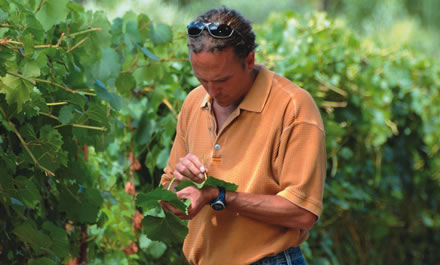 Dave Koball, vineyard director at Bonterra, looks for leafhoppers in Mendocino County, Calif. Overly vigorous growth encourages leafhopper populations, as well as mildew and Botrytis bunch rot. Large shady canopies also can result in reduced fruitfulness the following year.
Dave Koball, vineyard director at Bonterra, looks for leafhoppers in Mendocino County, Calif. Overly vigorous growth encourages leafhopper populations, as well as mildew and Botrytis bunch rot. Large shady canopies also can result in reduced fruitfulness the following year.Most organic winegrowers are focused closely on producing high-quality fruit that will make wines balanced, deeply flavored and expressive of the winegrape variety and place in which the fruit is grown. Organic winegrowers in California use many of the same viticultural practices as conventional growers. Canopy management practices are critical to vine balance, disease and pest control. Organic winegrowers need to carefully evaluate how pruning, irrigation, fertility, cultivar and rootstock, trellis system and canopy manipulations affect production, vine vigor, wine quality and profitability.
Part IV in a series on organic winegrowing In this series of articles, we will present information for growers and wineries interested in farming their vineyards organically, based on the author's knowledge and experience during the past 20 years of working with organic winegrowers in Lake and Mendocino counties. Glenn T. McGourty is a winegrowing and plant science adviser with the University of California Cooperative Extension in Mendocino County, Calif. The four parts of the series are:
Understanding your site
Vineyard design and variety selection are site specific. If you are going to achieve good economic returns, grow quality fruit and ultimately make good wine, it is important that you carefully match the site's capacity with your choice of rootstock, trellis and variety. Organic winegrowers always start by focusing on the soil, since it controls so many functions of crop growth and quality. If you are planning a new vineyard or seeking to better understand the growth of an existing vineyard, soil physical data can give you great insight as to how the vines are likely to grow:READ MORE »Growing & Winemaking
October 2008Depth Filtration vs. Crossflow
Figure 1: NTU vs. Pressure 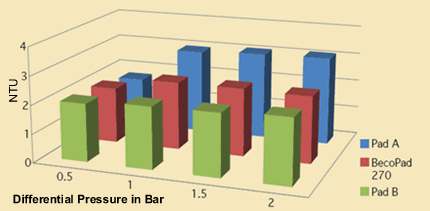 Nephelometric Turbidity (NTU) is a measure of the clarity of a liquid. The BecoPad shows equal or better clarity compared to standard pads with no high pressure breaching of the pads.
Nephelometric Turbidity (NTU) is a measure of the clarity of a liquid. The BecoPad shows equal or better clarity compared to standard pads with no high pressure breaching of the pads.
Source: Dr. Richard CareySeveral forces have driven changes in filtration technology during the last couple of decades, including environmental concerns, the health and safety of winery workers, and wine quality. The major active component in traditional depth filtration is diatomaceous earth (DE), which has several major problems. First, it is difficult to dispose of because it does not decompose. Second, it is a known health hazard--DE can cause symptoms similar to coal miners' "black lung" disease when inhaled over long periods of time.READ MORE »Growing & Winemaking
October 2008Fighting Disease Organically
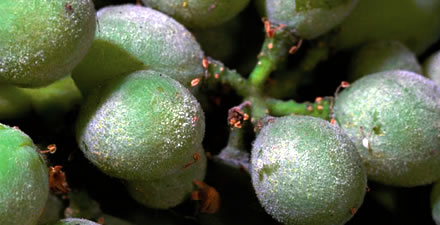 Powdery mildew is the most prevalent disease encountered in organically farmed vineyards.
Powdery mildew is the most prevalent disease encountered in organically farmed vineyards.
Copyright © University of California RegentsOrganic winegrowers face the same disease problems as conventional growers, and powdery mildew is the most prevalent disease encountered in organically farmed vineyards. Botrytis bunch rot also can be a problem some seasons with some varieties. Finally, trunk wood rotting and vascular diseases such as black measles and esca are also a problem, especially for older vineyards.READ MORE »Growing & Winemaking
October 2008Alternatives Go Mainstream
It's a segment of the wine industry that will continue to boom as long as the dollar remains fragile and large quantities of spice- and vanilla-laced wine are produced. Concurrently, the oak alternatives business will continue to be kinetic as high-end winemakers accept its products' perceived virtues and learn how to utilize them to their maximum benefit.READ MORE »Growing & Winemaking
September 2008Managing Pests Organically
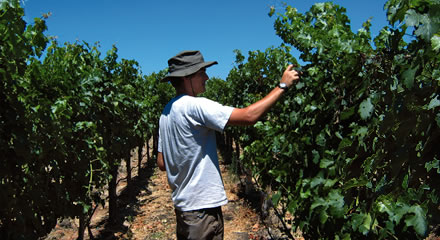 CJ Battey of the Kent Daane Laboratory at the University of California, Berkeley, releases Anagyrus pseudococci, a parasitoid that attacks second-, third- and adult-stage vine mealybugs.Organic winegrowers must deal with the same pests as conventional winegrowers. It is surprising to many that pest management is not a difficult task for most organic winegrowers, and that very effective strategies and organic pesticides are available. Yet at the beginning, most organic winegrowers undergo some very basic philosophical changes in pest management.READ MORE »
CJ Battey of the Kent Daane Laboratory at the University of California, Berkeley, releases Anagyrus pseudococci, a parasitoid that attacks second-, third- and adult-stage vine mealybugs.Organic winegrowers must deal with the same pests as conventional winegrowers. It is surprising to many that pest management is not a difficult task for most organic winegrowers, and that very effective strategies and organic pesticides are available. Yet at the beginning, most organic winegrowers undergo some very basic philosophical changes in pest management.READ MORE »Growing & Winemaking
September 2008Welcome these 'friends' to your organic vineyard
Error: Content not found; message sent to web administrator.

.png)
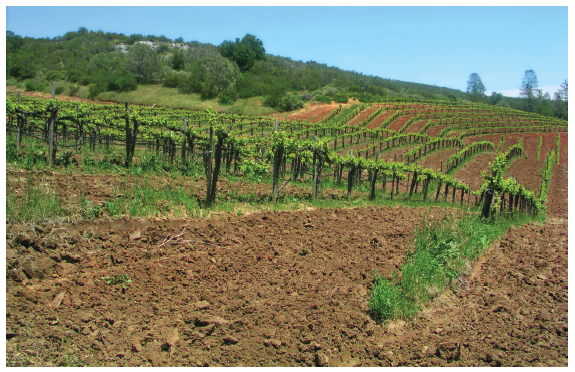
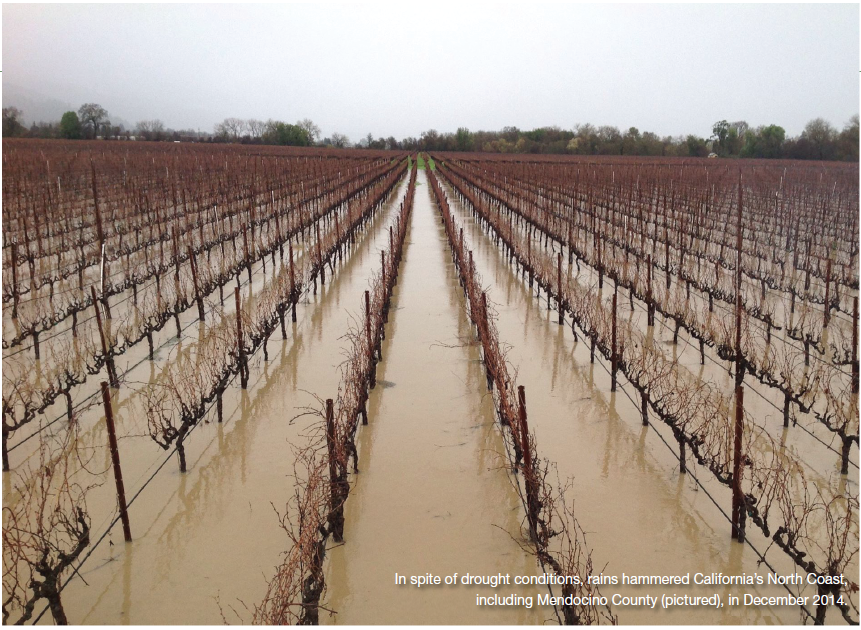
.png)
